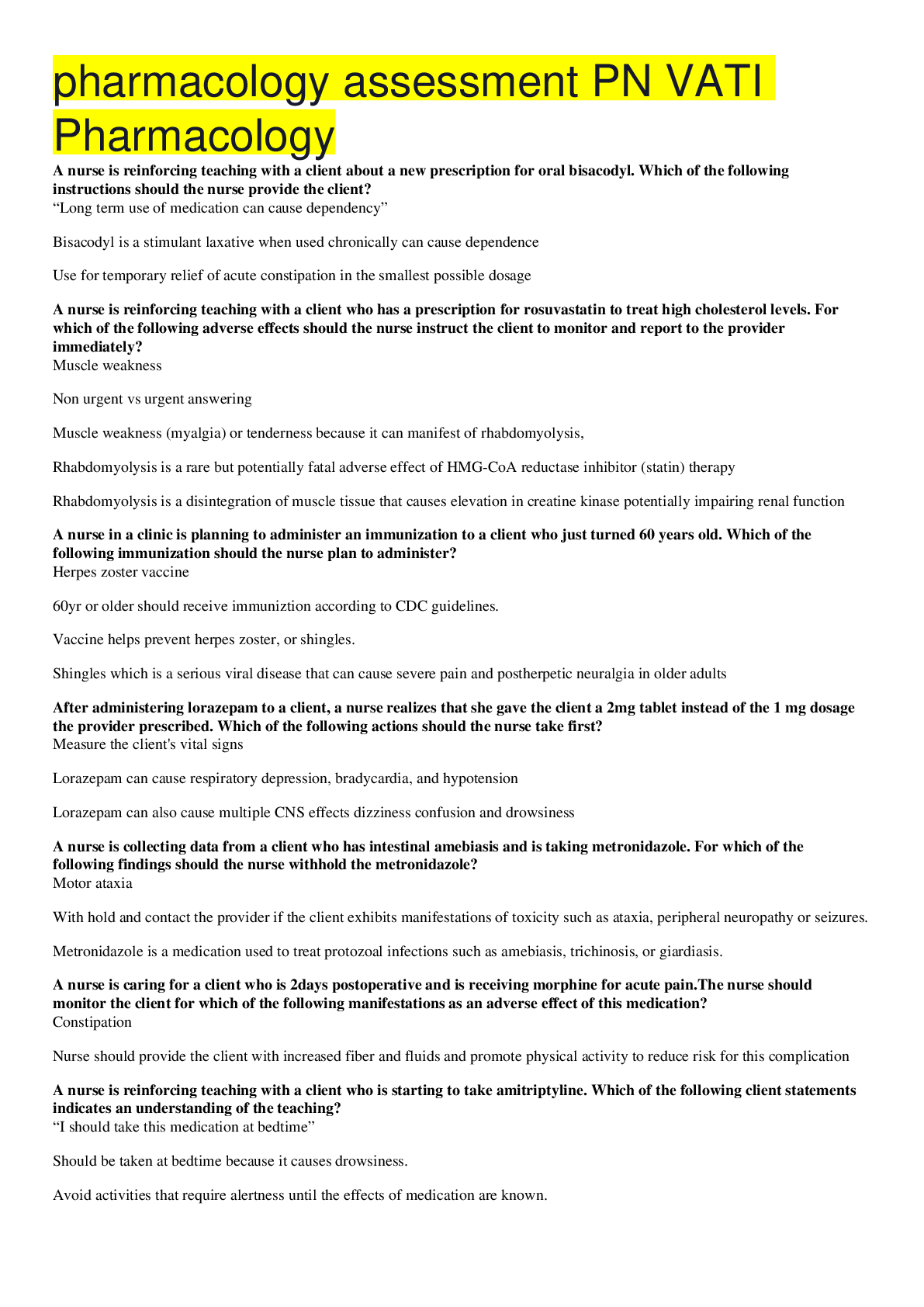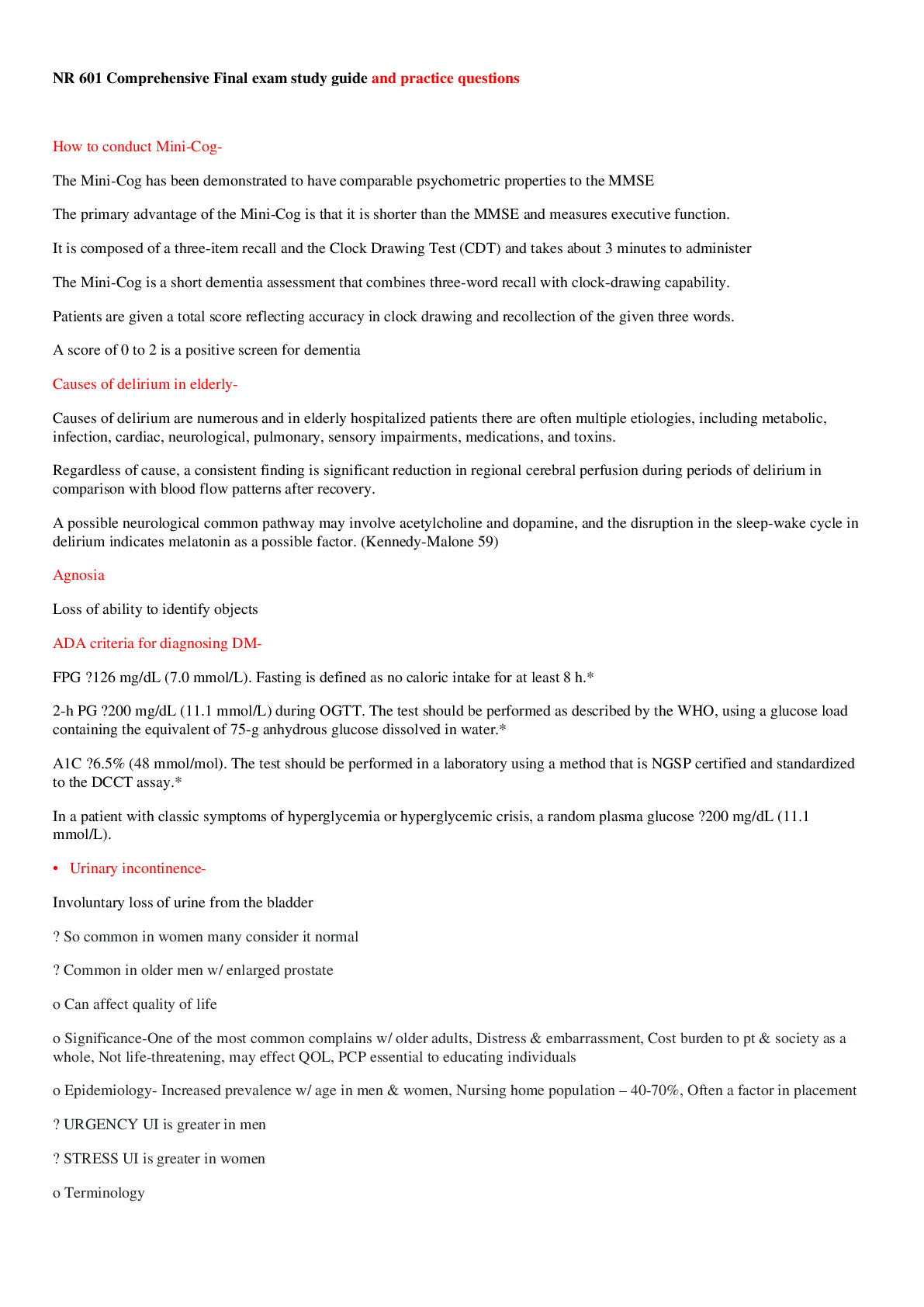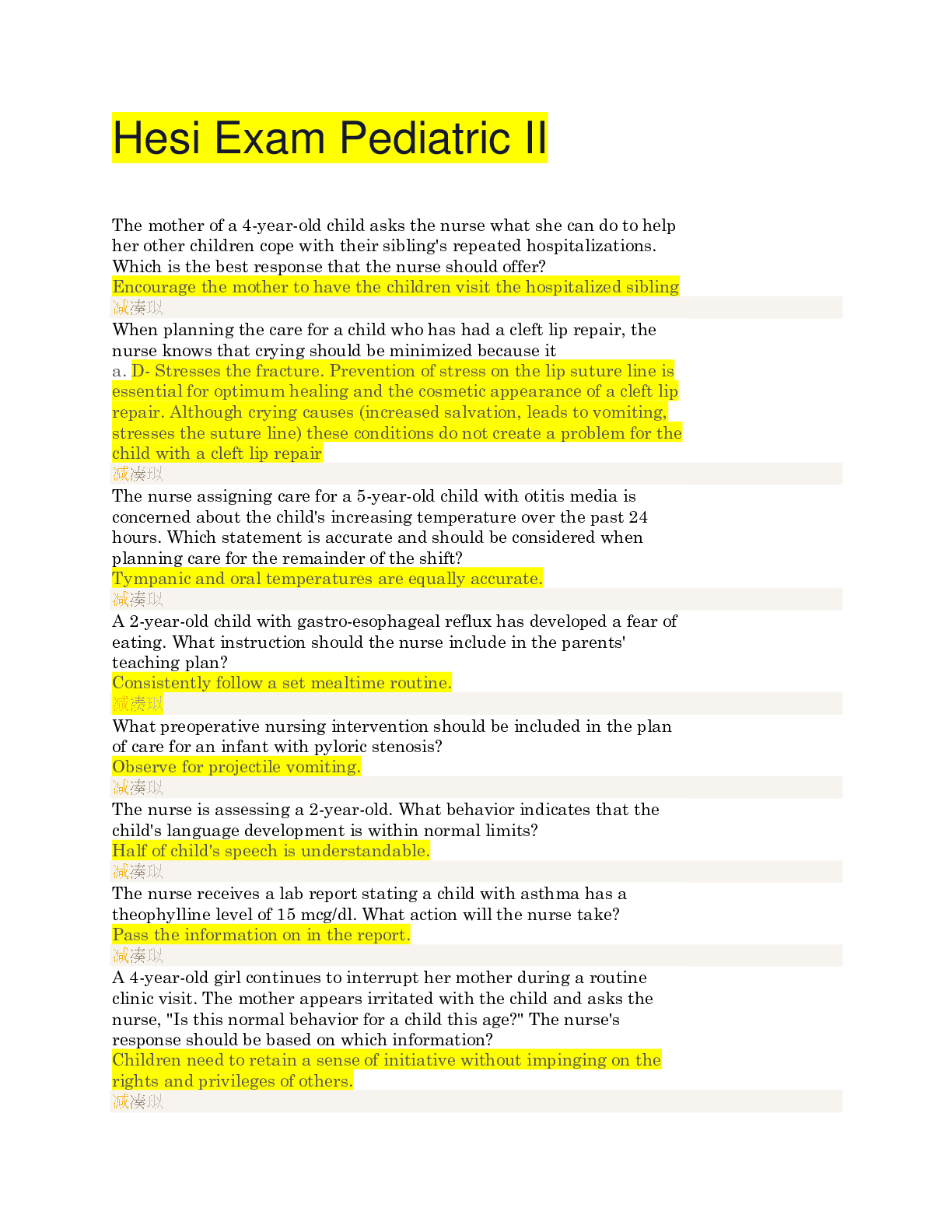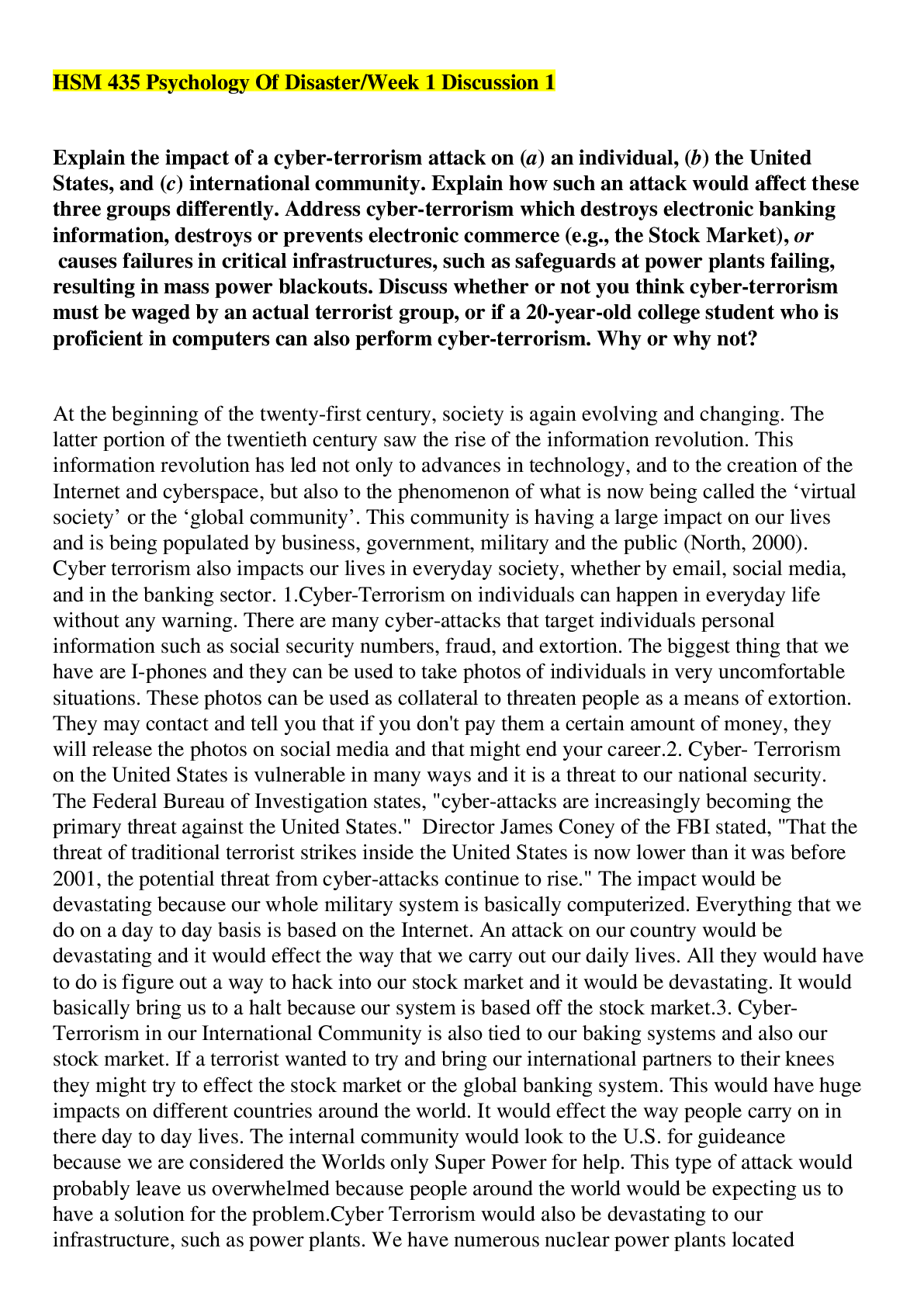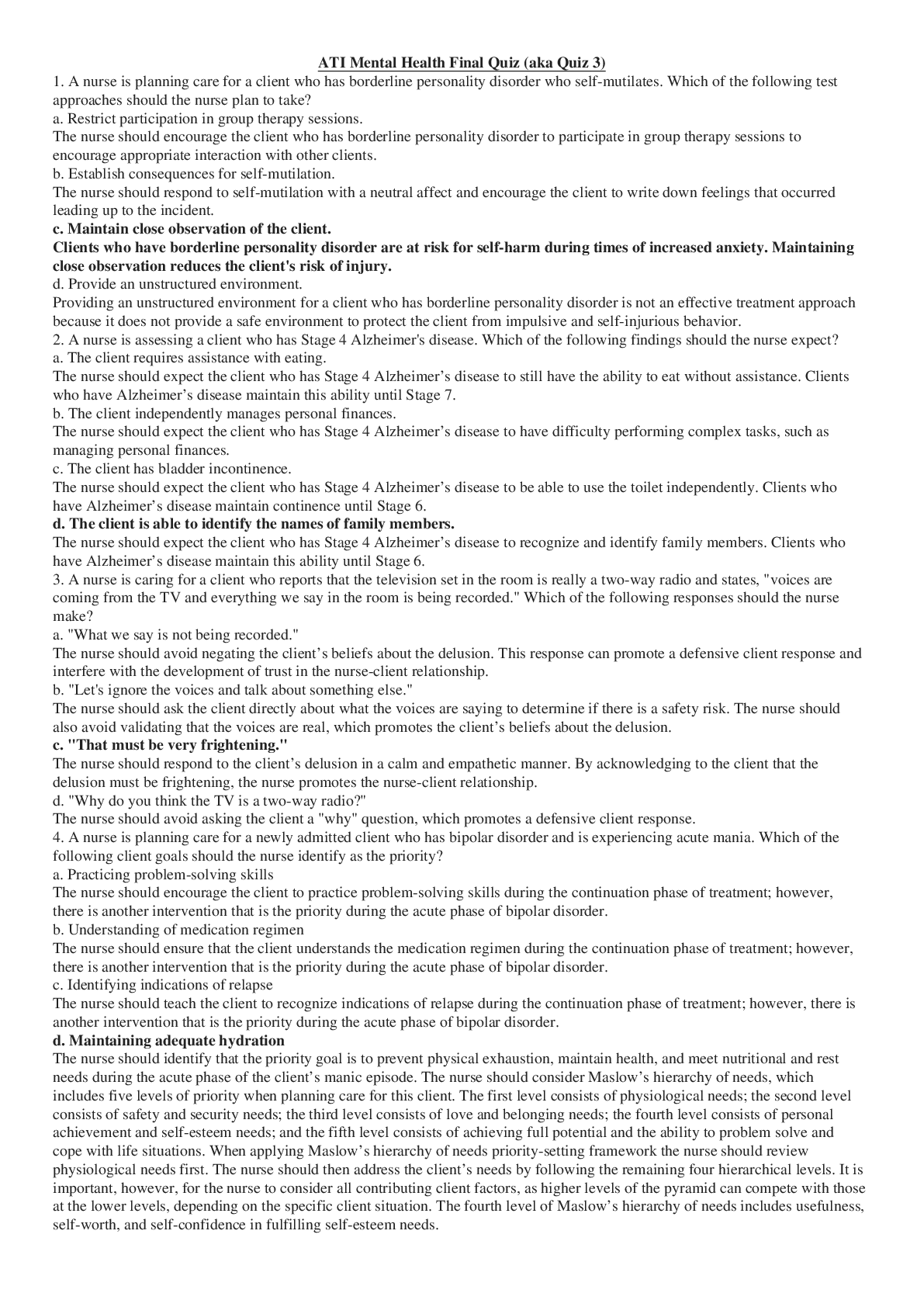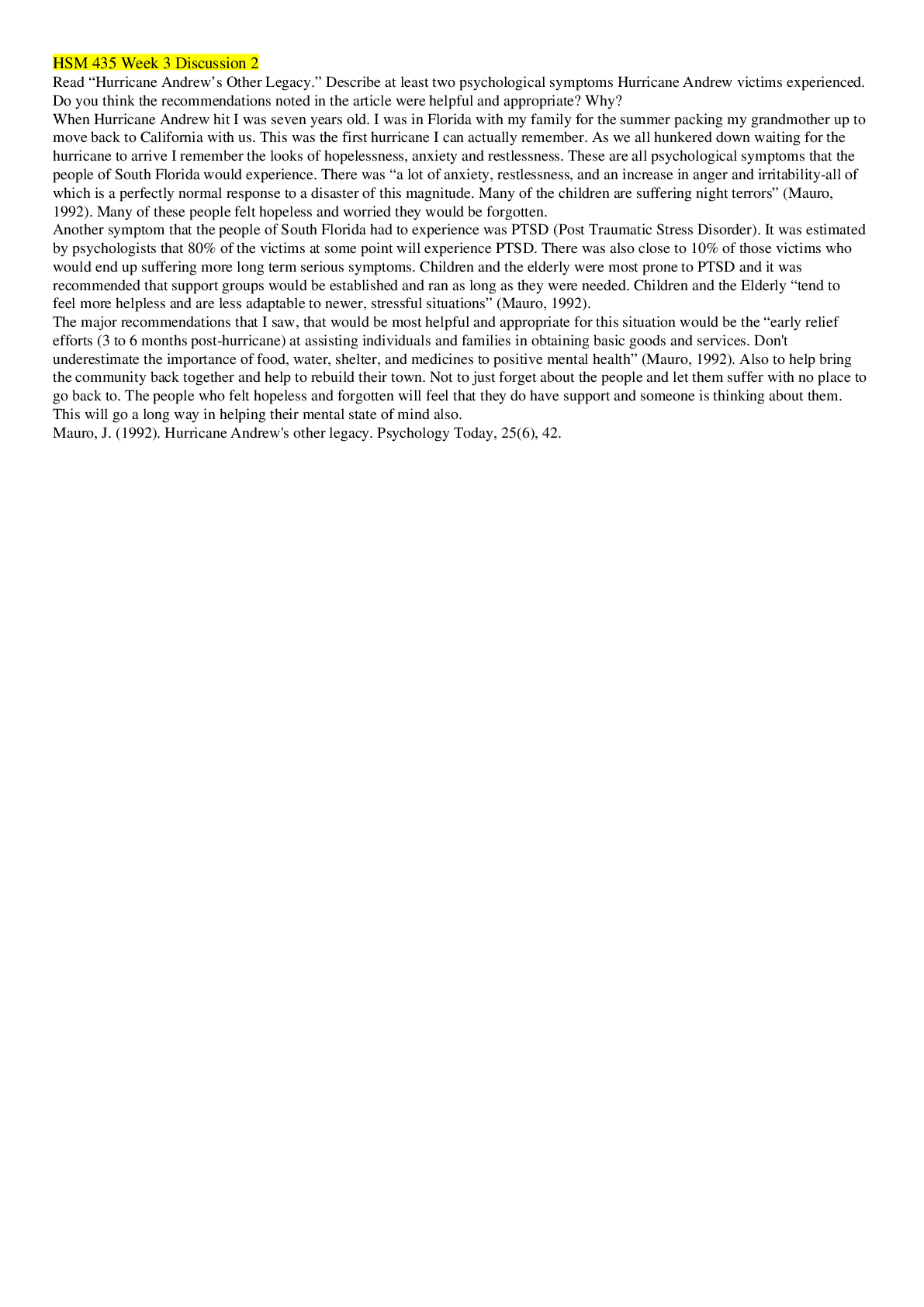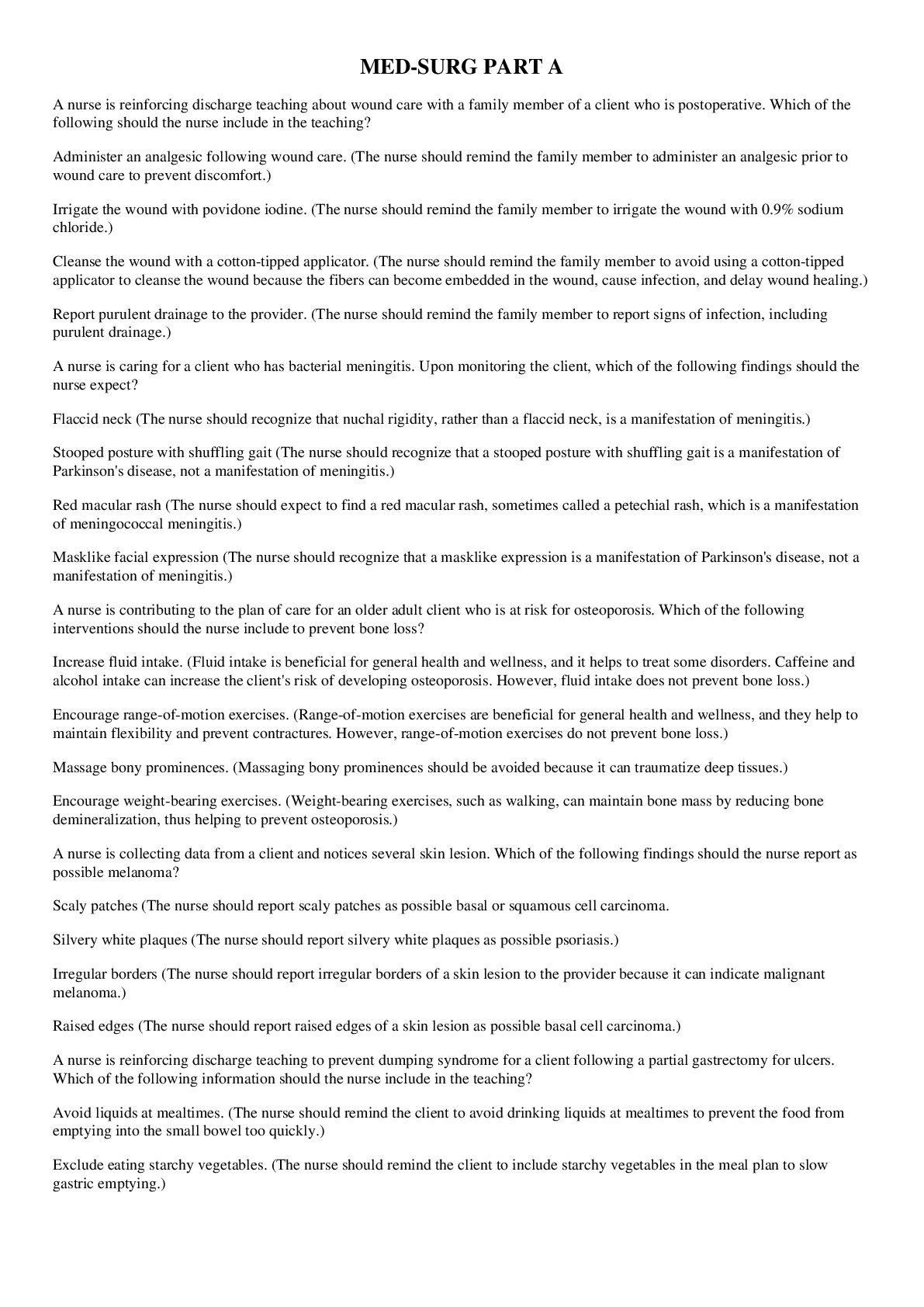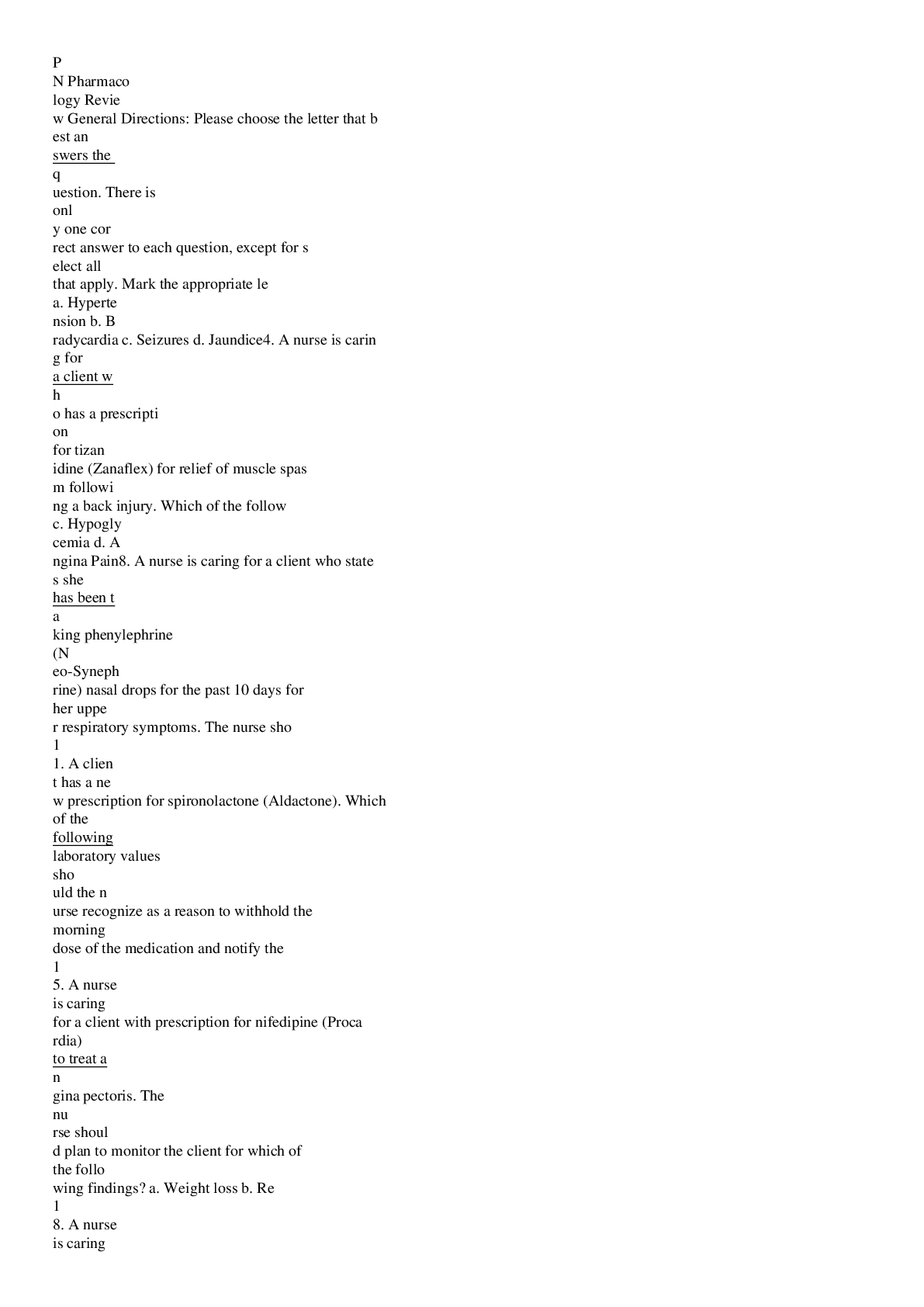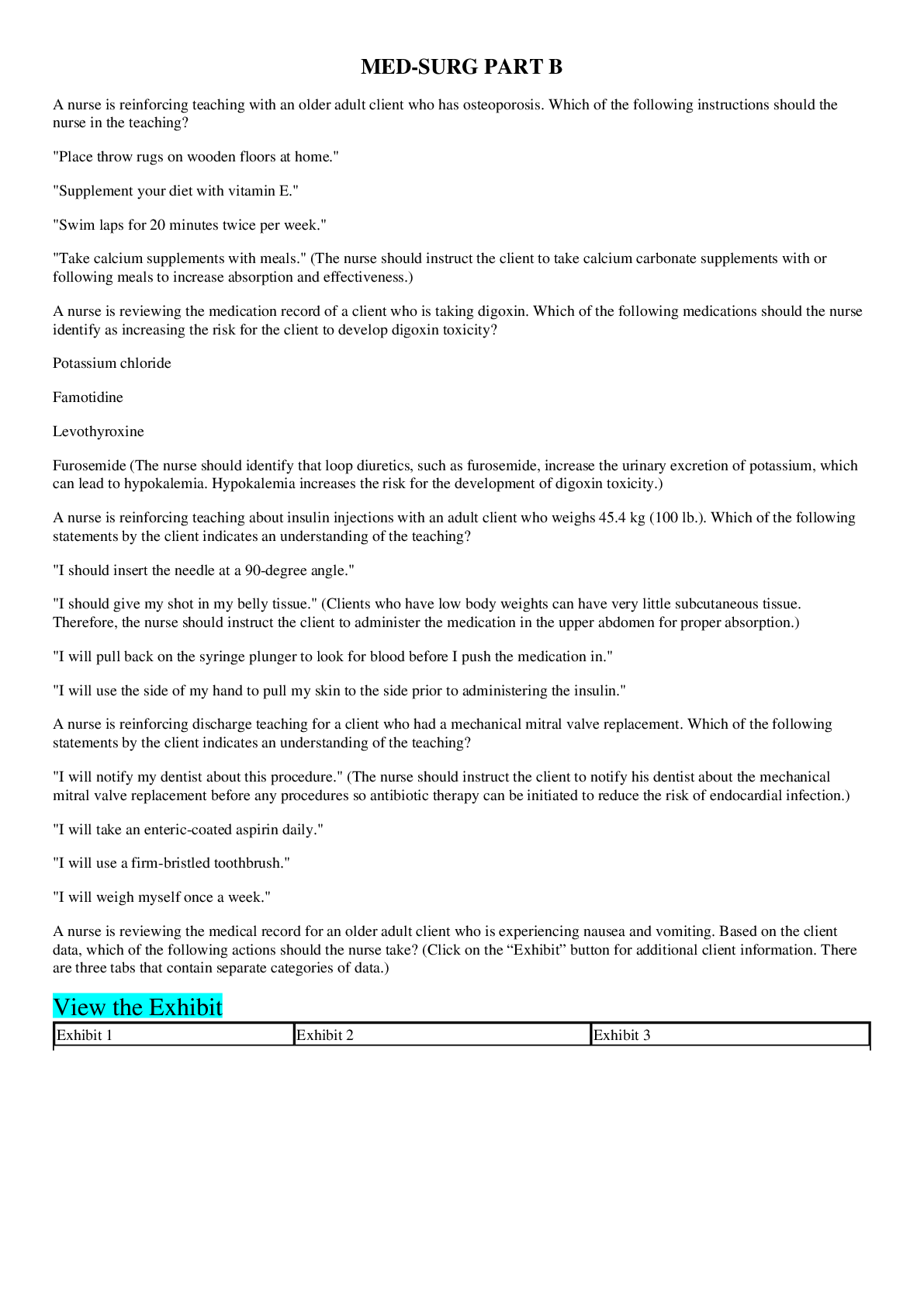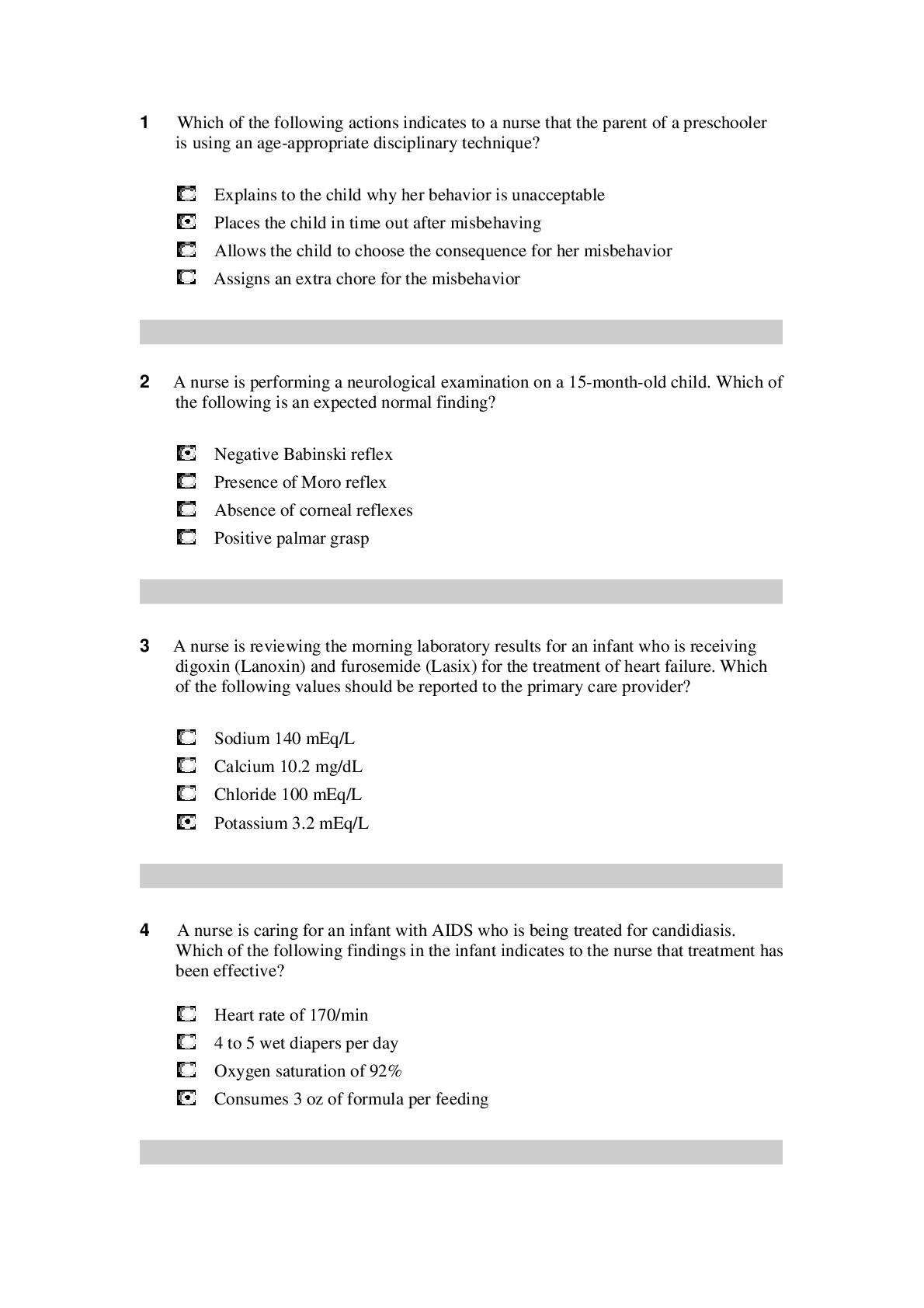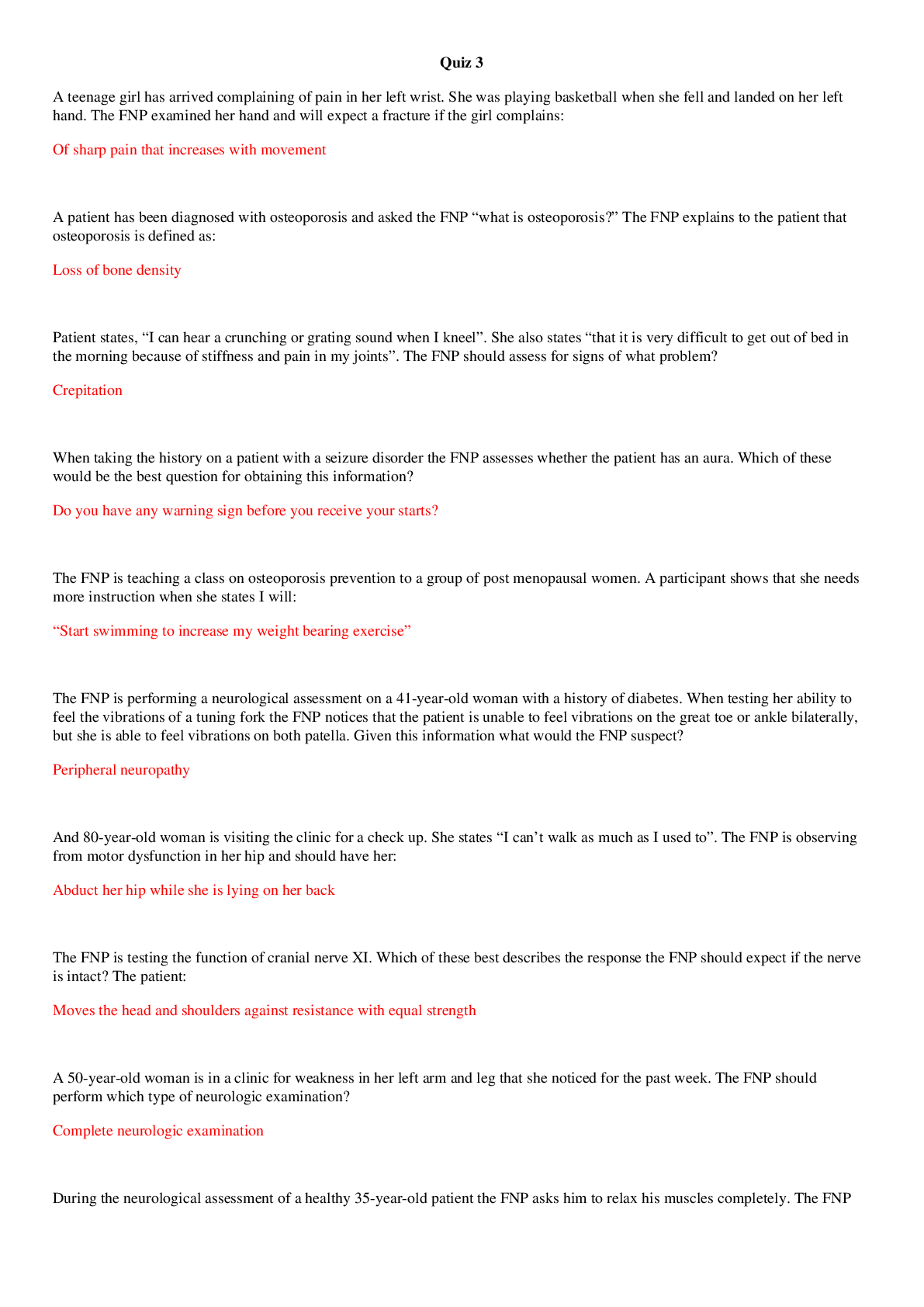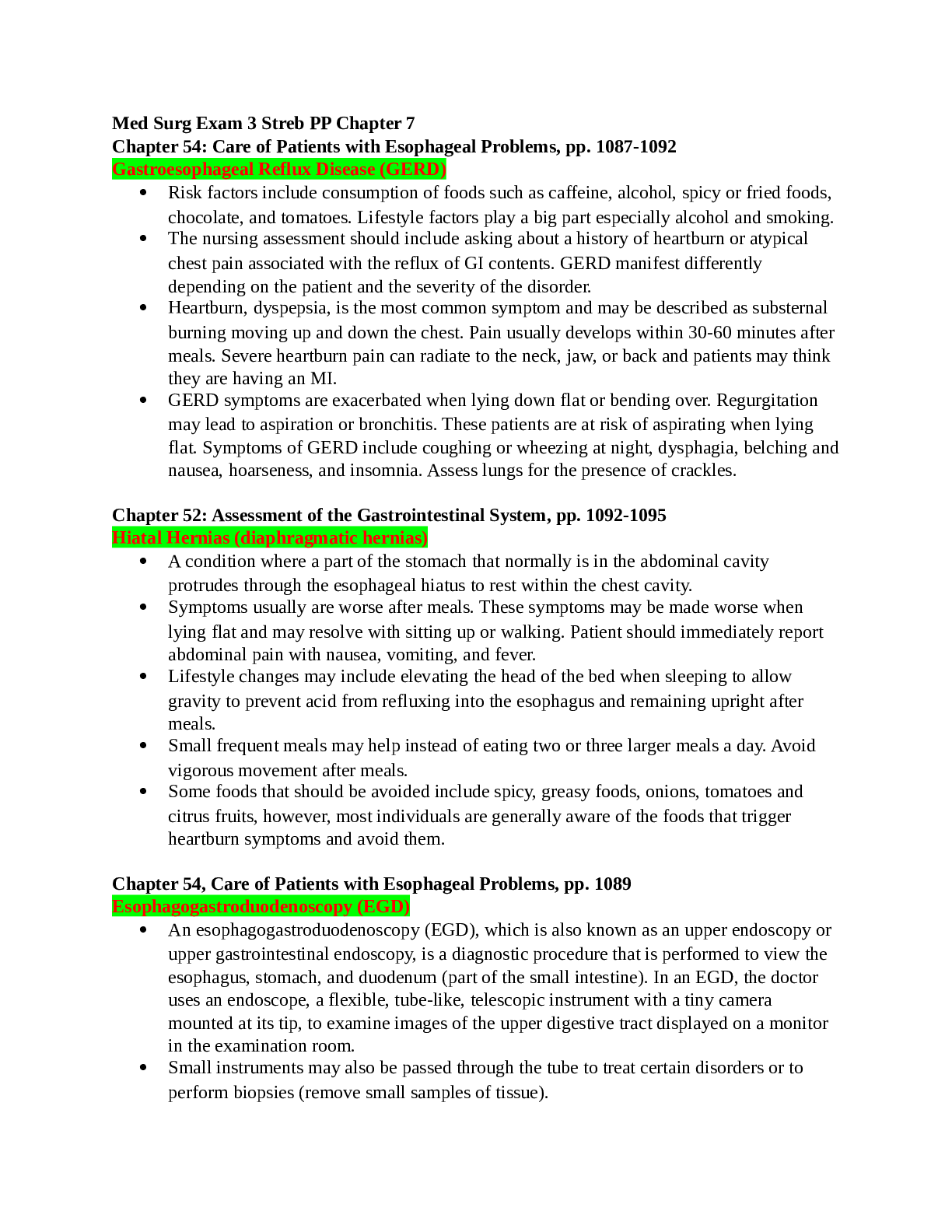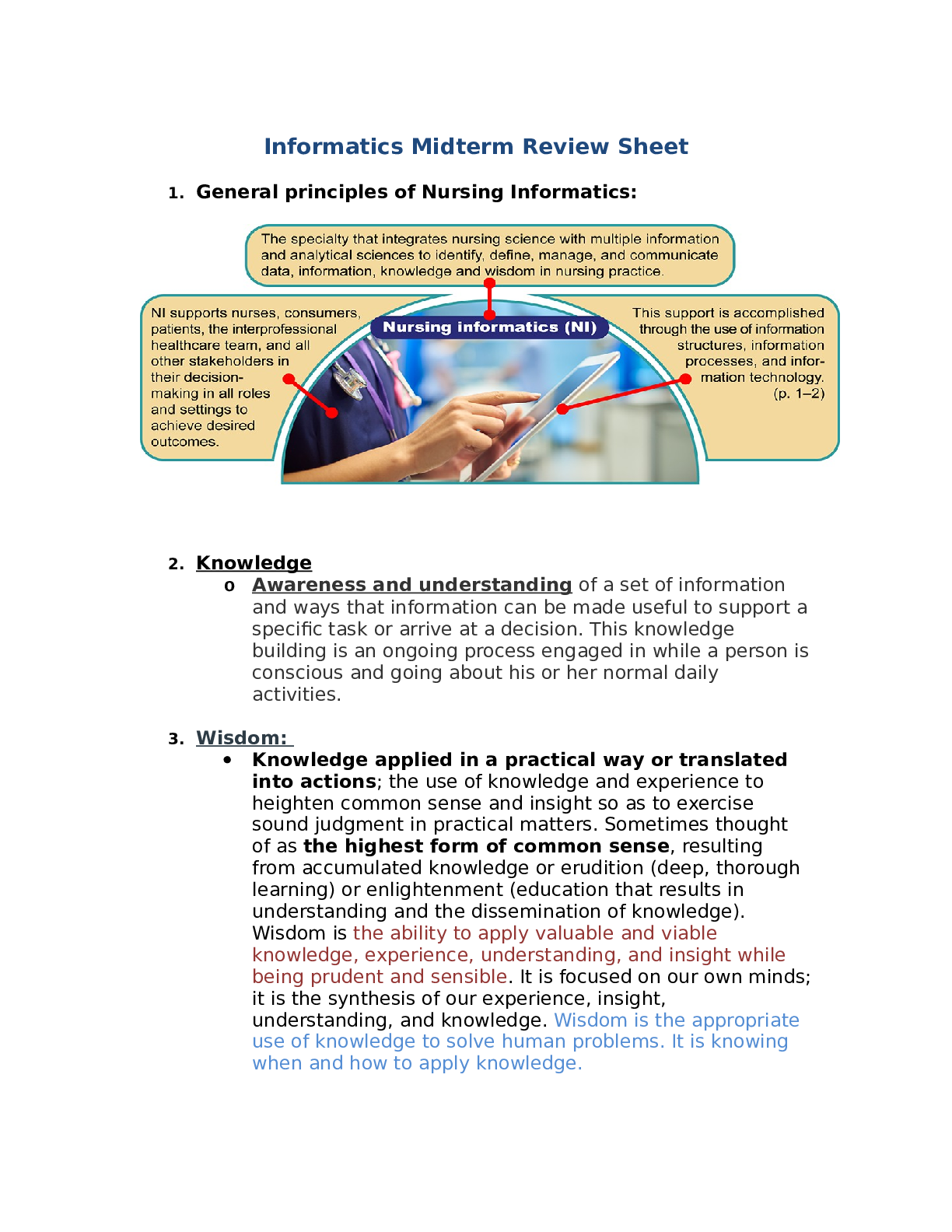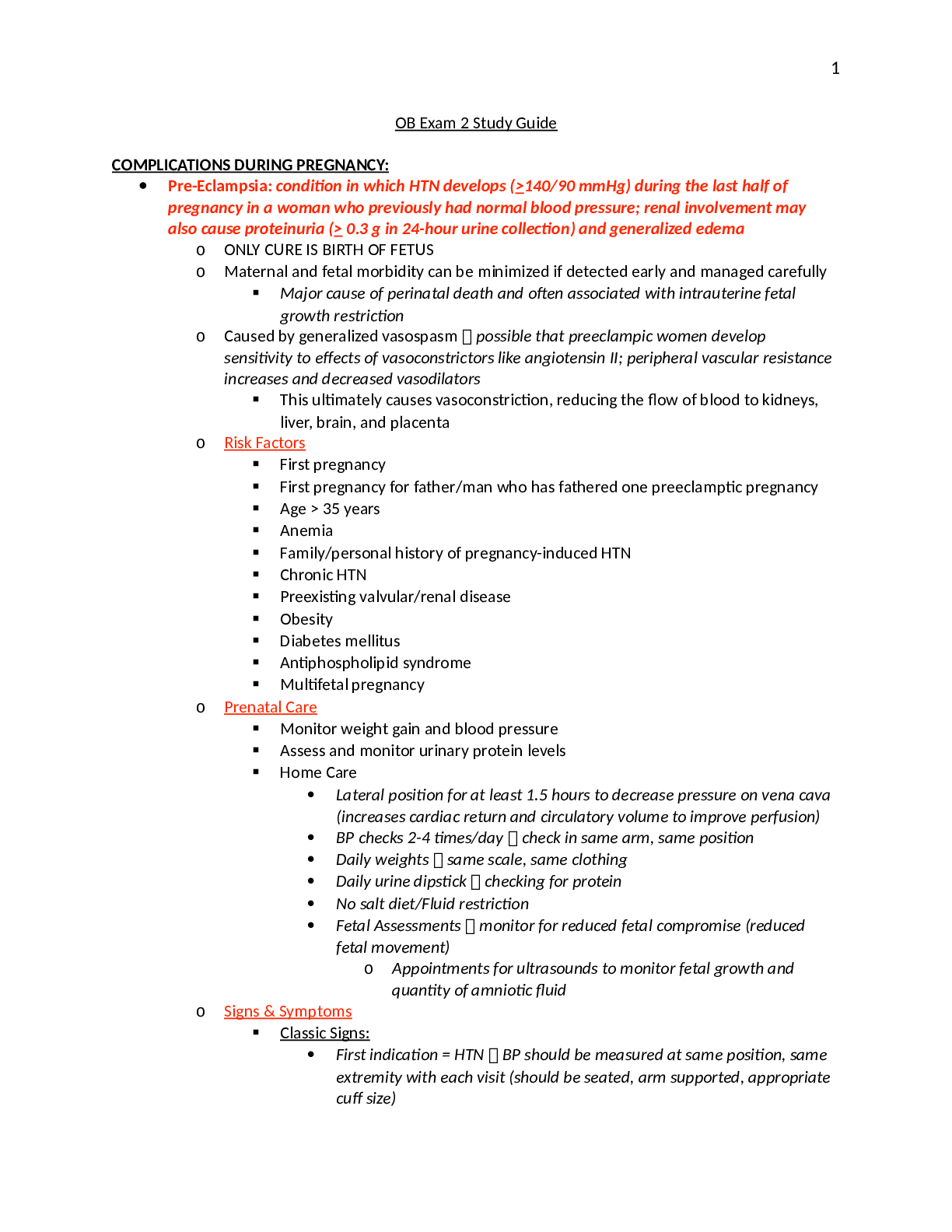*NURSING > STUDY GUIDE > Chamberlain College Of Nursing - NR 293 Practice Questions for neuro drugs|Nr 293 week 3 and 4 Pract (All)
Chamberlain College Of Nursing - NR 293 Practice Questions for neuro drugs|Nr 293 week 3 and 4 Practice questions for Neuro drugs-GRADED A
Document Content and Description Below
NR 293 Practice Questions for neuro drugs 1. What are examples of barbiturate-type hypnotic and sedative drugs? (Select all that apply.) a. Pentobarbital (Nembutal) b. Eszopiclone (Lunesta) c. Zolpide... m (Ambien) d. Triazolam (Halcion) e. Secobarbital (Seconal) 2. A nurse is caring for a patient who has been administered a barbiturate. Which is a symptom of barbiturate toxicity that the nurse must monitor the patient for? a. Restlessness b. Euphoria c. Hypotension d. Confusion 3. Anxiolytic drugs can be used in the management of which conditions? (Select all that apply.) a. Alcohol withdrawal b. Diabetic neuropathy c. Seizures d. Panic attacks e. Hypertension 4. What are examples of nonbenzodiazepine-type hypnotic and sedative drugs? (Select all that apply.) a. Temazepam (Restoril) b. Eszopiclone (Lunesta) c. Zolpidem (Ambien) d. Triazolam (Halcion) e. Zaleplon (Sonata) 5. Which drug used to treat anxiety would be appropriate for a client who is a school teacher and is concerned about feeling sedated at work? a. Alprazolam (Xanax) b. Buspirone (BuSpar) c. Diazepam (Valium) d. Lorazepam (Ativan) Rationale: Buspirone does not cause as much sedation and functional impairment as lorazepam, alprazolam, and diazepam. However, it can cause dizziness, nausea, headache, nervousness, lightheadedness, or excitement. 6. A group of students are reviewing information about antidepressants that inhibit the activity of monoamine oxidase, leading to increase in epinephrine, norepinephrine, dopamine, and serotonin. The students demonstrate understanding when they identify which drug as acting in this manner? a. Phenelzine b. Sertraline c. Amitriptyline d. Bupropion SSRIs include: • sertraline (Zoloft) • fluoxetine (Prozac, Sarafem) • citalopram (Celexa) • escitalopram (Lexapro) • paroxetine (Paxil, Pexeva, Brisdelle) • fluvoxamine (Luvox) 7. The nurse is caring for a client whose current drug regimen includes mirtazapine 15 mg PO daily. What assessment question should the nurse prioritize? a. "How would you describe your mood and energy level today?" b. "On a scale from zero to ten, how would you rate your anxiety level?" c. "How are you feeling today?" d. "Are you feeling happier today than in the past?" 8. Anticholinergic effects such as dry mouth, sedation, and urinary retention are common adverse events occurring with the use of which classes of antidepressants? a. Tricyclic antidepressants b. Selective serotonin reuptake inhibitors c. Monoamine oxidase inhibitors d. Atypical antidepressants 9. A nurse is caring for a patient with depression. The patient has been prescribed amitriptyline, a tricyclic antidepressant. What should the nurse identify as the effect of this antidepressant on the patient's body? a. Decreased reuptake of norepinephrine b. Increased serotonin in the nervous system c. Increased endogenous norepinephrine d. Increased endogenous epinephrine 10. A nurse educating a client starting phenelzine (Nardil) should educate the client to avoid which foods? (Select all that apply.) a. Blue cheese b. Pepperoni c. Apples d. Chocolate e. Celery 11. A client, prescribed fluoxetine 1 week ago, presents for a scheduled follow-up appointment. What should be the focus of the client’s nursing assessment? a. cardiac rate and rhythm b. presence of suicidal ideation c. improvement in the ability to concentrate d. indications of a type IV hypersensitivity reaction 12. While caring for a client receiving antipsychotic therapy, the nurse observes cogwheel rigidity, tremors, and drooling. The nurse interprets this as: a. pseudoparkinsonism. b. tardive dyskinesia. c. akathisia. d. dystonia. 13. The psychiatric nurse is conducting health education addressing the adverse effects of clozapine. What teaching point should the nurse convey to the client? a. “There’s a possibility that this drug might cause you to gain weight and have high blood sugar levels.” b. “Sometimes people who take this drug are more prone to getting infections such as colds and flus.” c. “There’s a chance that you could develop breathing problems when using this drug, making you vulnerable to pneumonia.” d. “You’ll have to eat more protein while you’re taking this drug to help heal any wounds.” 14. What is the purpose of a “drug holiday” for a teenager prescribed an amphetamine for attention deficit hyperactivity disorder (ADHD)? a. to minimize weight loss b. to prevent hyperthyroidism c. to allow electrolyte imbalances to resolve d. to slow bone resorption 15. A 29-year-old woman who is morbidly obese has recently begun a comprehensive, medically supervised program of weight reduction. Prior to adding dextroamphetamine (Dexedrine) to her regimen, the client should be questioned about her intake of: a. alcohol. b. trans fat. c. caffeine. d. grapefruit juice. 16. Lithium is not a true antipsychotic medication but is used to treat which antipsychotic disorder? a. Bipolar mania b. Bipolar depression c. Schizophrenia d. Personality disorder 17. A client is receiving haloperidol. The nurse would be especially alert for the development of which adverse effect? a. Sedation b. Anticholinergic c. Extrapyramidal d. Hypotension 18. A bipolar client is being discharged home in 48 hours. What statement by the client indicates an understanding of treatment with lithium? a. "I will increase my salt intake." b. "I will increase my fluid intake." c. "I will decrease my salt intake." d. "I will decrease my fluid intake." 19. A client’s medication history includes a long-term prescription for modafinil. Which assessment question should the nurse ask to confirm why the medication was prescribed? a. “Have you ever been diagnosed with attention deficit hyperactivity disorder (ADHD)?” b. “Have you ever been diagnosed with narcolepsy?” c. “Do you have a problem with sleepwalking?” d. “Do you have trouble falling asleep?” 20. A client should be educated concerning the effect of combining theophylline with what chemical substance? a. methylphenidate b. atomoxetine c. modafinil d. caffeine it content nicotine 21. A pediatric client has been admitted to the floor and started on ritalin therapy for AHDH. The nurse knows that an important daily intervention for this client would be which? a. weigh the client daily. b. record a daily summary of client's behavior. c. perform ROM exercises daily. d. suction the client daily. 22. The nurse is caring for a client who has been taking an oral neuroleptic medication for several years. What assessment should the nurse prioritize to best address the risk for adverse effects? a. Assessment of bowel pattern and stool character b. Monitoring the client’s cranial nerve function c. Assessment of deep tendon reflexes d. Monitoring the client for involuntary facial movements 23. A group of nursing students are reviewing information about CNS stimulants. The students demonstrate understanding of the information when they identify which drug as being used to treat obesity? a. Phentermine b. Dexmethylphenidate c. Modafinil d. Methylphenidate 24. A client has been admitted to the emergency department and is experiencing tonic-clonic seizures. What intervention should the nurse prioritize? a. Administration of phenytoin IV as prescribed b. Administration of gabapentin PO as prescribed c. Assessment of the client's renal and hepatic function d. Establishing a therapeutic relationship with the client 25. A client is prescribed a catechol-O-methyltransferase (COMT) inhibitor. Which drug would the nurse expect to administer? a. Entacapone b. Carbidopa c. Benztropine d. Biperiden 26. A client is newly diagnosed with parkinsonism and has been prescribed levodopa. After several weeks, no appreciable reduction in symptoms has been noted. The nurse should anticipate what change in the client’s medication regimen? a. Adding carbidopa to the client’s medication regimen b. Addition of vitamin B6 to the client’s medication regimen c. Substitution of diphenhydramine for levodopa d. Temporary change in levodopa route from oral to intravenous 27. After administering an antiparkinson drug to a client, the nurse assesses for the drug’s effectiveness. The nurse determines that the drug is effective based on assessment of which of the following? Select all that apply. a. Decrease in muscle rigidity b. Improved gait c. Reduction in tremors d. Greater slowing of movement e. Reduced dry mouth 28. A client with spinal cord injury is experiencing muscle spasticity. Which agent would most likely be ordered? a. Baclofen Muscle relaxant It can treat muscle spasms. b. Carisoprodol c. Chlorzoxazone d. Cyclobenzaprine 29. What would the nurse expect to assess in a client receiving a narcotic for pain relief? a. Dilation of the pupils b. Diarrhea c. Orthostatic hypotension d. Tachypnea 30. Which adverse reactions may occur as a result of administering an opioid antagonist? a. Diarrhea, cramping, and increased pain rating b. Decreased blood pressure and decreased pulse c. Increased temperature and decreased oxygen saturation d. Sweating, tachycardia, and increased blood pressure 31. A nurse is caring for a client diagnosed with migraine headaches. Which nursing intervention should be implemented during an acute headache? a. Administer subcutaneous sumatriptan succinate (Imitrex). b. Administer naproxen. c. Administer ergotamine subcutaneously. d. Administer diclofenac. 32. A male client is given regular doses of morphine for a period of 6 months. His dosage now needs to be reduced gradually. The health care provider advises the nurse to pay attention to the clinical management of the client's pain to allow proper agonist coverage during the change in drug dosage. Why is the client likely to suffer unnecessary pain and discomfort if proper management is not ensured? a. Tolerance to the drug b. Physical dependence on the drug c. Addiction to the drug d. Adverse effects of the drug 33. The nurse has administered a dose of naloxone (Narcan) and the client's respiratory depression improved within five minutes. When the nurse reassessed the client two hours later, the client demonstrates symptoms of respiratory depression. Which action should the nurse perform next? a. No further action is required because the naloxone has already been administered. b. Call the provider as another dose of opioid antagonist may be necessary. c. Administer a second dose and then notify the provider to obtain an order. d. Continue to monitor the client's vital signs and oxygen saturation levels. 34. Although naloxone (Narcan) is given to counter opioid medication side effects such as respiratory depression, what additional issues (if any) may result from administration of an opioid antagonist? a. Increase in the client's pain rating b. Decrease in the client's pain rating c. No change in the client's pain rating d. None of these options 35. The nurse anesthetist correctly identifies the following to be types of local anesthesia. (Select all that apply.) a. Topical application b. Local infiltration c. Regional anesthesia d. General anesthesia e. Gases 36. The nurse is caring for a client with no known medical conditions who will receive general anesthesia through balanced anesthesia. The nurse understands that the client may receive some or all of what drugs? (Select all that apply.) a. Corticosteroids b. Benzodiazepines c. Antihypertensives d. Neuromuscular blocking agents e. Opioid analgesics 37. The operating room nurse is taking the client into the operating room when the client says his grandmother almost died from a high fever in surgery 15 years ago. What is the nurse’s best action? a. Ensure that cooling blankets are available in the operating room b. Immediately ensure that the anesthesiologist is aware of this c. Monitor the client’s temperature closely during induction and maintenance of anesthesia d. Document the client’s statement in the health record promptly 38. The client is scheduled for a colonoscopy. Which drug would the nurse expect to be given to the client prior to the procedure to promote conscious sedation? a. ativan b. midazolam c. robinul d. citanest 39. The nurse is preparing a client who will receive intravenous anesthetic during a short surgical procedure. The nurse understands that this client is most likely to receive which medication? a. Diazepam b. Nitrous oxide c. Isoflurane d. Propofol 40. An adult client who is currently undergoing rhinoplasty has developed the characteristic signs and symptoms of malignant hyperthermia. The operating room nurse should anticipate what intervention? a. hemodialysis b. tracheal intubation c. IV administration of naloxone d. IV administration of dantrolene sodium ________________________________________ Answer Key 1 A, E 2 C 3 A, C, D 4 B, C, E 5 B 6 A 7 A 8 A 9 A 10 A, B, D 11 B 12 A 13 A 14 A 15 C 16 A 17 C 18 B 19 B 20 D 21 B 22 D 23 A 24 A 25 A 26 A 27 A, B, C 28 A 29 C 30 D 31 A 32 B 33 B 34 A 35 A, B, C 36 B, D, E 37 B 38 B 39 D 40 D Addition 20: Anxiolytic and Hypnotic Agents Confusion Rationale: The nurse should look for signs of confusion in the elderly patient when monitoring the effects of the administered drug. Headache, stress, and anxiety are causes of insomnia. CLICK THE ARROWS BELOW TO ADVANCE A patient who suffers from GERD and diverticulosis has just been admitted to a medical floor. The admitting physician orders cimetadine and a sedative to calm the patient. About what should the nurse be concerned? Increased sedative effect Rationale: An increased sedative effect may occur when a sedative is given with cimetidine for gastric upset. The other options do not play a role in providing the best care for the patient. 1/46 Terms in this set (46) An elderly patient is administered a sedative for the treatment of insomnia. Which sign should the nurse look for in the patient when monitoring the effects of the administered drug? Confusion Rationale: The nurse should look for signs of confusion in the elderly patient when monitoring the effects of the administered drug. Headache, stress, and anxiety are causes of insomnia. A patient who suffers from GERD and diverticulosis has just been admitted to a medical floor. The admitting physician orders cimetadine and a sedative to calm the patient. About what should the nurse be concerned? Increased sedative effect Rationale: An increased sedative effect may occur when a sedative is given with cimetidine for gastric upset. The other options do not play a role in providing the best care for the patient. A client is receiving a barbiturate intravenously. The nurse would monitor the client for: bradycardia. Rationale: When given intravenously, barbiturates can result in bradycardia, hypotension, hypoventilation, respiratory depression, and laryngospasm. Bleeding is not associated with barbiturate therapy. A patient receiving halcion 0.25 mg PO at bedtime appears very drowsy and is difficult to rouse when the nurse enters the room. Based on these findings, what would be the best nursing diagnosis for this patient? Risk for injury Rationale: Based on the data, the best nursing diagnosis would be risk for injury related to drowsiness. The dose of the halcion appears to be too much for this patient and it is making him difficult to rouse. The nurse would be most alert for what issue in a patient who is receiving an intravenous barbiturate? Hypotension Rationale: Hypotension is a possible effect when barbiturates are given IV. Bradycardia, not tachycardia, can occur with IV barbiturate administration. Hypoventiliation can occur with IV barbiturate administration. Bleeding is not associated with intravenous barbiturate use. A student demonstrates understanding of benzodiazepines, identifying which as the prototype? Diazepam Rationale: Diazepam is considered the prototype benzodiazepine. A client receives an oral dose of diazepam at 4:00 PM. The nurse would expect to see the maximum effect of this drug at approximately which time? 5:30 PM Rationale: Diazepam peaks in approximately 1 to 2 hours, so the maximum effect of the drug would be seen between 5 and 6 PM. A patient undergoing treatment with barbiturates is showing symptoms of barbiturate toxicity. Which intervention should the nurse perform? Provide respiratory assistance Rationale: The nurse must provide respiratory assistance to the patient showing symptoms of barbiturate toxicity. Providing assistance with movement, supportive care, and a safe environment are suggested for patients at risk for injury due to drowsiness or impaired memory. Which action would be least appropriate for the nurse to do after administering an anxiolytic to a patient? Having the patient walk to the bathroom Rationale: Having the patient walk to the bathroom would be appropriate before administering the drug to reduce the patient's risk for injury. Raising the side rails would be appropriate after administering an anxiolytic. Placing the call light within reach would be appropriate after administering an anxiolytic. Dimming the lights would be appropriate after administering an anxiolytic. The difference between normal and abnormal anxiety is: Abnormal anxiety is prolonged and impairs the ability to function normally. Rationale: Anxiety is usually responsive to drug therapy. Although there is no clear boundary between normal and abnormal anxiety, when anxiety is severe or prolonged and impairs the ability to function in usual activities of daily living, it is called an anxiety disorder. Insomnia, prolonged difficulty in going to sleep or staying asleep long enough to feel rested, is the most common sleep disorder. Situational anxiety is a normal response to a stressful situation. Symptoms may be quite severe, but they usually last only 2 to 3 weeks. A nurse is caring for an elderly patient undergoing antianxiety treatment. The patient is to be administered antianxiety drugs parenterally. What precautions should be taken by the nurse? Have resuscitative equipment ready. Rationale: The nurse should have resuscitative equipment ready because elderly patients may experience apnea and cardiac arrest during the treatment. Providing fiber-rich food and plenty of fluids is not a precautionary measure during the parenteral administration of the drug. The need for a blood transfusion would not arise during the treatment. A patient's medication regimen for treatment of anxiety has been changed from a benzodiazepine to buspirone (BuSpar). The patient asks the nurse what makes this medication safer than the benzodiazepine he has taken. What is the nurse's best response? "It will not produce sedation like benzodiazepines." Rationale: Buspirone will not produce sedation. Compared with the benzodiazepines, buspirone (BuSpar) lacks muscle relaxant and anticonvulsant effects; does not cause sedation or physical or psychological dependence; does not increase the CNS depression of alcohol and other drugs; and is not a controlled substance. Medication reconciliation of an 82-year-old man who has recently moved to a long-term care facility reveals that the man takes 1 to 2 mg of lorazepam bid prn. The nurse should recognize what consequence of this aspect of the resident's drug regimen? Increased risk for falls Rationale: In a systematic review of medications as risk factors for falls, it was found that one of the main group of drugs associated with this risk were benzodiazepines. Benzodiazepines are not associated with cold intolerance, anorexia, or aggression. The prototype for benzodiazepines is: diazepam. Rationale: Diazepam is the prototype benzodiazepine. High-potency benzodiazepines such as alprazolam, lorazepam, and clonazepam may be more commonly prescribed due to their greater therapeutic effects and rapid onset of action. After reviewing the various drugs that are classified as barbiturates, a student demonstrates understanding when identifying which as the prototype? Phenobarbital Rationale: Phenobarbital is considered the prototype barbiturate. Patients taking benzodiazepines, especially elderly patients, are at high risk for: falls. Rationale: Patients taking benzodiazepines, especially elderly patients, are at high risk for falls and should be counseled on fall prevention measures. The nurse is describing an anxiolytic that has no sedative, anticonvulsant, or muscle relaxant properties, but is effective in reducing the signs and symptoms of anxiety. Which agent would the nurse most likely be describing? Buspirone Rationale: Buspirone has no sedative, anticonvulsant, or muscle relaxant properties, but it does reduce the signs and symptoms of anxiety. Zaleplon causes sedation and is used for short-term treatment of insomnia. Meprobamate has some anticonvulsant properties and central nervous system relaxing effects. Diphenhydramine is an antihistamine that can be sedating. A client has received a benzodiazepine for sedation before a diagnostic procedure. Which agent would the nurse expect the client to receive to reverse the sedative effects? Flumazenil Rationale: Flumazenil is the antidote for benzodiazepines and is used to reverse the sedation of benzodiazepines used for diagnostic procedures. Temazepam and triazolam are benzodiazepines used as hypnotics. Promethazine is an antihistamine with sedative effects. A group of nursing students answers correctly if they identify which medication as the prototype benzodiazepine? Diazepam (Valium) Rationale: Diazepam (Valium) is the prototype benzodiazepine. High-potency benzodiazepines such as alprazolam (Xanax), lorazepam (Ativan), and clonazepam (Klonopin) may be more commonly prescribed due to their greater therapeutic effects and rapid onset of action. A patient with a known seizure disorder is admitted to the intensive care unit with a diagnosis of septic shock. The patient is being sedated with midazolam (Versed). Following discontinuation of the medication, the patient remains sedated for several days. Based on the patient's history, what is the rationale for not treating with flumazenil (Romazicon)? Increased risk of seizures Rationale: Although the risk of adverse effects with benzodiazepine is high in critically ill patients, routine use of flumazenil, the benzodiazepine antidote, is generally not recommended because it may cause seizures or cardiac arrest. These effects are most likely to occur in people with a history of seizures, cardiac arrest, head injury, cerebral hypoxia, or chronic benzodiazepine use. The administration of flumazenil will not place the patient at risk for hypertension. The administration of flumazenil will not place the patient in deeper sedation. The administration of flumazenil will not decrease the level of agitation. A male client is admitted to the emergency department via ambulance. He is attempting to pull out his IV line, exhibiting symptoms of agitation, and thrashing about. The physician orders a benzodiazepine-type sedative. What information is needed prior to administration of the drug? Whether the client is experiencing drug intoxication or withdrawal Rationale: Some clients become acutely agitated or delirious and need sedation to prevent their injuring themselves by thrashing about, removing tubes and intravenous (IV) catheters, and so forth. Some physicians prefer a benzodiazepine type sedative, whereas others may use haloperidol. Before giving either drug, causes of delirium (e.g., drug intoxication or withdrawal) should be identified and eliminated if possible. A group of students are reviewing information about benzodiazepines. The group demonstrates understanding of the material when they state that what drug would be used as a hypnotic? Flurazepam Rationale: Flurazepam would be used as a hypnotic. Lorazepam is used as an anxiolytic. Diazepam is used as an anxiolytic. Alprazolam is used as an anxiolytic. The nurse should not administer sedatives or hypnotic drugs to which client? Comatose client Rationale: The nurse should not administer these drugs to comatose clients, those with severe respiratory problems, those with a history of habitual drug and alcohol use, or pregnant or lactating women. The nurse could safely administer sedatives or hypnotics to a client with a history of asthma as long as the client is not having an acute attack. A woman of childbearing age can receive sedatives or hypnotics after it is confirmed she is not currently pregnant. An egg allergy is not a contraindication to sedative or hypnotic administration. A 39-year-old patient who is having trouble sleeping is beginning drug treatment with zaleplon (Sonata). The nurse will be sure to ask if the patient is taking: cimetidine (Zantac). Rationale: The nurse will assess for cimetidine use. Cimetidine greatly increases the level of circulating zaleplon and could cause toxic effects in the patient. Secobarbital is a barbiturate, and oxycodone and meperidine are narcotics that would not be used with lorazepam because the combinations may depress respiratory drive, create severe hypotension or bradycardia, and substantially alter level of consciousness. A 70-year-old patient has just started taking lorazepam 10 days ago for anxiety issues related the death of her husband. She is staying with her daughter for a couple of weeks. The patient's daughter has noticed that her mother is having difficulty walking and seems to be confused at times and calls the clinic to report this to the nurse. The nurse will inform the daughter that: a dose adjustment should be made if these symptoms persist. Rationale: If ataxia and confusion occur, especially in older adults or in a debilitated patient, dose adjustments should be made if the effects persist. If the drug is stopped immediately, withdrawal symptoms may occur. Intravenous administration or continuing the same dosage and medication would not help relieve ataxia or confusion in the patient. A nurse is caring for a patient whose physician has ordered a benzodiazepine sedative-hypnotic. The nurse knows that most of these drugs are used with caution in patients with which disorders? Liver disease Rationale: Benzodiazepines undergo hepatic metabolism. In the presence of liver disease, the metabolism of most benzodiazepines is slowed, with resultant accumulation and increased risk of adverse effects. A 70-year-old male client asks why he is receiving a lower dose of zaleplon than his son. As part of the nurse's teaching plan, which explanation will the nurse give this client? "Older adults metabolize the drug more slowly, and half-lives are longer than in younger adults." Rationale: In older adults, most non-benzodiazepines are metabolized more slowly, and half-lives are longer than in younger adults. Exceptions are lorazepam and oxazepam, whose half-lives and dosages are the same for older adults as for younger ones. The recommended initial dose of zaleplon or zolpidem is 5 mg, one half of the initial dose recommended for younger adults. Dosages of eszopiclone should also be reduced for older adults, beginning with 1 mg initially, not to exceed 2 mg at bedtime. The nurse administers diazepam (Valium) to a client preoperatively for what purpose? Decreased anxiety Rationale: Preoperative medications are used to decrease anxiety, decrease secretions, decrease nausea and to decrease pain. Diazepam (Valium) is intended to decrease anxiety prior to surgery. Which agent has no sedative, anticonvulsant, or muscle relaxant properties but does reduce the signs and symptoms of anxiety? Buspirone Rationale: Buspirone has no sedative, anticonvulsant, or muscle relaxant properties, but it does reduce the signs and symptoms of anxiety. Diphenhydramine is an antihistamine that can be sedating. Zaleplon causes sedation and is used for short-term treatment of insomnia. Meprobamate has some anticonvulsant properties and CNS-relaxing effects. A client asks when eszopiclone should be taken to promote sleep. What is the nurse's best response to this client? "Eszopiclone is rapidly absorbed after oral administration, reaching peak plasma levels 1 hour after administration." Rationale: Eszopiclone is rapidly absorbed after oral administration, reaching peak plasma levels 1 hour after administration. Onset of action may be delayed by approximately 1 hour if the drug is taken with a high-fat or heavy meal. Eszopiclone has a half-life of 6 hours. A 28-year-old patient is to receive a dose of lorazepam intravenously for sedation during a procedure. The nursing priority would be to assess for: respiratory disturbances and partial airway obstruction. Rationale: An agent classified as a hypnotic is used primarily for preventing the feelings of tension or fear. False Rationale: Hypnotics are used because they can cause sleep; anxiolytics can prevent the feelings of tension or fear. If a pregnant patient has taken a benzodiazepine during pregnancy, what should be the biggest concern? The infant may experience withdrawal symptoms during the postnatal period. Rationale: Women taking barbiturates and benzodiazepines should be warned of the potential risk to the fetus so that contraception methods may be instituted. A child born to a mother taking a benzodiazepine may experience withdrawal during the postnatal period. A 34-year-old executive for an insurance company has been taking lorazepam for the last 6 months for anxiety. The client abruptly stopped the medication. The client then calls the physician and reports feeling irritable, increased heart rate, and restlessness. What would explain the client's current symptoms? withdrawal from stopping the medication Rationale: Prolonged administration of lorazepam or any other benzodiazepine produces physical dependence, and withdrawal symptoms occur if the drug is stopped suddenly. The symptoms of withdrawal include restlessness, irritability, tachycardia, insomnia, and sweating. Dependence is not synonymous with addiction. A patient who is experiencing acute alcohol withdrawal is being treated with intravenous lorazepam (Ativan). This drug achieves a therapeutic effect by: increasing the effects of the neurotransmitter GABA. Rationale: Like all benzodiazepines, lorazepam increases the effects of GABA, which has an inhibitory effect on the CNS. However, none of the benzodiazepines act like GABA or increase the amount of GABA present. MAOIs inhibit monoamine oxidase and tricyclic antidepressants primarily affect serotonin and norepinephrine levels. SSRIs increase the availability of serotonin in the synapses. A client received a parenteral benzodiazepine at 11 AM. The nurse would expect to allow the client out of bed at which time? 2 PM Rationale: Clients who receive parenteral benzodiazepines should be monitored in bed for a period of at least 3 hours. Thus, the client would be allowed out of bed at approximately 2 PM. What are the most important physical assessments for a nurse to perform when admitting a client diagnosed with elevated blood pressure due to anxiety? (Select all that apply.) • Skin temperature and color • Respiratory rate • Blood pressure Rationale: During the intake exam, a focused physical assessment for anxiety should include checking blood pressure, pulse, respiratory rate, and weight. Physiologic manifestations of anxiety can include increased blood pressure and pulse rate, increased rate and depth of respiration, and increased muscle tension. An anxious client may have cool and pale skin. Bowel sounds and hair texture would not be as important as assessing blood pressure, respiratory rate, and skin temperature for the client who is anxious. A patient admitted to the health care facility for insomnia related to stress is prescribed a sedative. What intervention should the nurse perform to promote the effects of the sedative? Provide back rubs Rationale: The nurse must provide back rubs to the patient to promote the effects of the sedative. Providing plenty of fluids and fiber-rich foods are measures taken to prevent constipation. Providing beverages does not help to promote the effect of the sedatives. Which drug used to treat anxiety would be appropriate for a patient who is a school teacher and is concerned about feeling sedated at work? Buspirone (BuSpar) Rationale: Buspirone does not cause as much sedation and functional impairment as lorazepam, alprazolam, and diazepam. However, it can cause dizziness, nausea, headache, nervousness, lightheadedness, or excitement. A hospitalized client asks the nurse why the health care provider prescribed an anxiolytic medication. What is the nurse's best response? "This type of medication is typically prescribed to treat excess anxiety that interferes with daily activities." Rationale: Drugs used to treat anxiety are called antianxiety, or anxiolytic, drugs. Long-term use of benzodiazepines, such as Xanax, can result in physical or psychological dependence. Due to the risk of dependence, benzodiazepines are used for short-term anxiety relief. Due to the risk of dependence, anxiolytics are classified as schedule IV contolled substances. Therefore, anxiolytics require a prescription. Anxiolytic drugs exert their tranquilizing effect by blocking certain neurotransmitter sites. What are examples of nonbenzodiazepine-type hypnotic and sedative drugs? (Select all that apply.) • Zolpidem (Ambien) • Eszopiclone (Lunesta) • Zaleplon (Sonata) Rationale: Eszopiclone, zolpidem, and zaleplon are examples of nonbenzodiazepine-type hypnotic and sedative drugs. After teaching a patient who is receiving zolpidem, the patient demonstrates understanding of the information when the patient states that the drug should be taken: before going to bed. Rationale: Zolpidem is taken before bedtime and the patient needs to devote 4 to 8 hours for sleeping. A nurse has been taught to observe for adverse reactions whenever administering a medication. One non-nervous system reaction after giving a sedative is: nausea. Rationale: Adverse nervous system reactions associated with sedatives and hypnotics are dizziness, drowsiness, and headache. A common GI reaction is nausea. What should the nurse's pre-administration physical assessment for the administration of an anxiolytic include? (Select all that apply.) • Blood pressure • Pulse • Respiratory rate • Weight Rationale: The nurse's pre-administration physical assessment for the administration of an anxiolytic should include blood pressure, pulse, respiratory rate, and weight. A patient is having seizure activity and the physician has ordered diazepam (Valium) to be given parenterally. If this medication is administered intravenously, when will its onset of action be observed? 1-5 minutes Rationale: Intravenous diazepam (Valium) is administered intravenously to decrease seizure activity and has a 1-5-minute onset of action. Diazepam (Valium) decreases seizure activity in less than 7-10 minutes. Diazepam (Valium) should decrease seizure activity is less than 10 minutes. Diazepam (Valium) will take more than 1 minute to begin working. A patient admitted to the health care facility for alcohol withdrawal has been prescribed an antianxiety medication. Why should the nurse suggest the patient stop consuming alcohol while therapy is ongoing? Increased risk for CNS depression Rationale: The nurse should suggest that the patient stop consuming alcohol while therapy is going on because such consumption increases the risk for CNS depression. Increased risk for digitalis toxicity is identified when the patient is taking digoxin for management of cardiac problems. Increased risk for sedation and respiratory depression is identified when tricyclic antidepressants or antipsychotics are being used simultaneously. YOU MIGHT ALSO LIKE... 39 terms KARCH CH 20 Anxiolytics 55 terms Pharmacology Chapter 20 Anxiolytic & Hypnotic Agents 153 terms Psychopharmacology 31-36 153 terms Psychopharmacology 31-36 OTHER SETS BY THIS CREATOR 117 terms 301 Final 166 terms Final Pharm Exam 50 terms Chapter 23: Anti-seizure Agents PREPU 51 terms Chapter 47: Lipid-Lowering Agents PREPU THIS SET IS OFTEN IN FOLDERS WITH... 15 terms CHAPTER 20 - ANXIOLYTIC AND HYPNOTIC AGENTS - PrepU Practice Questions 83 terms Pharmacology Antiparkinson Drugs 62 terms Chapter 57: Drugs Affecting Gastrointestinal Secretions PREPU 107 terms NUR 316- Chap 22 Prep U PSychotherapuetic Only $1/month Create Upgrade to Quizlet Plus jeszoequiz 106 terms KBug27 Anesthetics - Prep U Study Guide STUDY PLAY Only $1/month A client with a foreign body embedded in her hand requires local anesthesia for removal. What drug would be most appropriate? CLICK THE CARD TO FLIP IT Benzocaine CLICK THE ARROWS BELOW TO ADVANCE A client is scheduled for dental surgery and will be given nitrous oxide. What assessment should the nurse prioritize before administering the medication? Respiratory status 1/106 Terms in this set (106) A client with a foreign body embedded in her hand requires local anesthesia for removal. What drug would be most appropriate? Benzocaine A client is scheduled for dental surgery and will be given nitrous oxide. What assessment should the nurse prioritize before administering the medication? Respiratory status Administration of which class of medications can decrease secretions of the upper respiratory tract? Cholinergic antagonists A patient admitted to a health care facility for appendicitis surgery is administered methohexital as a general anesthesia. Which condition should the nurse observe in the patient as the effect of the administration of methohexital? CNS depression The nurse is working in the postanesthesia care unit, and several patients are having surgery today. Which patient would be at greatest risk for complications after surgery? A 72-year-old female who had general anesthesia for lung removal The nursing student identifies which people as qualifed to administer anesthesia? (Check all that apply.) -Anesthesiologist -Nurse anesthetist A client has suffered a severe laceration to the thumb and index finger during a workplace accident, and local anesthetic is to be utilized to facilitate suturing. Which of the client's statements should prompt the nurse to provide further health education? "I'm feeling pretty queasy about getting stitches, so I'm glad they'll be knocking me out." A 29-year-old female client in labor has just received epidural anesthesia. Before the procedure her blood pressure was 120/78 and her pulse was 60 bpm. Now her blood pressure is 100/60 and her pulse is 80 bpm. She reports a metallic taste in her mouth, hears a ringing in her ears, and appears confused. What is this client most likely experiencing? Systemic toxicity from local anesthesia A 44-year-old woman has been admitted to the hospital for lower abdominal surgery. She appears anxious and expresses concerns about the epidural procedure. What would be a therapeutic way to manage this client's anxiety? Demonstrate active listening through eye contact and posture and then ask open-ended questions. The client is to have a spinal anethesisa for surgery. While educating the client, which statement by the nurse is correct regarding the insertion of the needle? A small gauge needle will be inserted into the subarachnoid space and medication will be administered into the cerebrospinal fluid. Benzocaine (Dermoplast) is a topical anesthetic that is short acting and has a quick onset. The duration is 30 to 60 minutes. How long is the onset of action of this medication? 1 minute A 12-year-old client will undergo surgery with spinal anesthesia. The client expresses a severe fear of needles. Which nurse response is appropriate and therapeutic for this client? "I understand that you are nervous, but I'll hold your hand and be right there with you." The client has had a swimming accident and lacerated his foot on a broken bottle in the water approximately 3 cm. The nurse is prepared to assist the healthcare provider with what type of anesthesia? Local The 35-year-old client has presented to the OB ward for her third delivery by cesarean section. The nurse who is caring for this client prepares for which type of anesthesia? Spinal The client is having a kidney removed due to a tumor. The circulating nurse in the operating room knows that which stage of anesthesia will be most dangerous to the client? Stage IV What is the most important nursing action when a client is admitted to the postanesthesia recovery unit (PACU)? Ensure the client has adequate respirations. There are different stages of anethesia the client will go through in surgery. The circulating nurse is aware that extra caution is needed during which stage of general anesthesia, when the client may experience brief periods of delirium and excitement? Stage II Gas anesthetics such as nitrous oxide must be combined with what element before they can be administered to the client? oxygen Prior to the administration of a topical local anesthetic, what is the nurse's priority assessment? Intact skin What is one of the registered nurse's primary roles in the administration of general anesthetic? Assessing the client's status during recovery from anesthetic The post-anesthetic recovery unit nurse is caring for a client whose balanced anesthesia included midazolam. The nurse should prioritize assessments for what health problems? Respiratory depression and CNS suppression The nurse at an urgent care clinical is reviewing local anesthetics. What drug should the nurse recognize as an amide? Lidocaine Inhaled anesthetic vapors are composed of volatile liquids. Which represent volatile liquids? (Select all that apply.) -Halothane -Desflurane -Enflurane A nurse is providing care for a patient who suffered extensive burns to the extremities during a recent industrial accident. Topical lidocaine gel has been ordered to be applied to the surfaces of all the burns in order to achieve adequate pain control. When considering this order, the nurse should be aware that: there is a risk of systemic absorption of the lidocaine through the patient's traumatized skin. The nursing student makes the following statement during post conference in the clinical setting, "The difference between local and general anesthesia is very small. The client is unaware of his or her surroundings during both types." Is this true or false? False The anesthesia care provider visits with the client prior to surgery. The choice of type of drugs to administer to the client during surgery are based on what factors? Select all that apply. -General physical condition of the client -Area, organ, or system being operated on -Anticipated length of the surgical procedure The client is undergoing surgery for a small bowel resection. At this time the client is experiencing complete respiratory paralysis and is in the most dangerous stage of general anesthesia. Which stage is this? Stage 4 The following are nonbarbiturate general anesthetics. Place in the proper sequence based on their onset of action from fastest to slowest. 1.Ketamine 2.Propofol 3.Etomidate 4.Droperidol Spinal anesthesia using procaine has been ordered for a patient prior to revision of the patient's ankle hardware. This drug achieves anesthesia by Preventing the influx of sodium into nerve cells. A man with no significant medical history is being prepared for outpatient surgery under general anesthesia. As part of the preparation for surgery, the anesthesiologist administers atropine, a anticholinergic agent. What is the purpose of administering this medication at this time? Dry up secretions in the respiratory tract. A 30-year-old client is to receive tetracaine (Pontocaine) via spinal anesthesia for an abdominal procedure. What should the nurse do to prevent side effects of this type of anesthesia? Maintain the client in a supine position following the procedure. A 37-year-old client has received procaine hydrochloride (Novocain) in the mouth for a dental procedure. How would the nurse evaluate that the outcome of reduced pain related to a dental procedure has been met? The client's facial expressions are calm and relaxed. A 36-year-old will receive Carbocaine for a dental procedure. The maximum dose of mepivacaine (Carbocaine, Polocaine) is 6 mg/kg. If this client weighs 60 kg, what is the maximum dose the client could receive? 360 What is the most important teaching point for a client after surgery when the client had epidural anesthesia? Ambulate with assistance The nurse is preparing to admit a client who has received conscious sedation. What is the most important area to assess when the client returns from the procedureusing this type of anesthesia? Respirations The nurse knows that the client is completely pain-free and ready for the surgical procedure during which stage of surgery? Stage III A client received fentanyl during a surgical procedure. The nurse will have what drug available to treat any possible respiratory depression associated with the use of fentanyl? Naloxone Which anesthetic is associated with a bizarre state of unconsciousness in which the client appears to be awake and yet cannot feel pain? Ketamine Which agent would the nurse identify as always being given with oxygen? Nitrous Oxide he nurse is caring for a client in the post-anesthetic care unit (PACU). The client is disoriented and agitated, with an increased heart rate and respiratory rate. What is the nurse's best action? Provide reassurance to the client while providing close monitoring Stage I of Anesthesia: -Stage of Analgesia -Begins with the administration of the anesthetic agent -Ends when the patient becomes unconscious. -Hearing is amplified at the end of this stage Stage II of Anesthesia: -the excitment phase. -muscles become tense -swallowing and vomiting reflexes are still present. -breathing may become illregular or the breath may be held. -The enviorment must be quiet during this period Stage III of Anesthesia: Also known as Surgical Anesthesia, -the skeletal muscles relax -vomiting stops -respiratory depression occurs -eye movements slow and then stop. The patient is unconscious and ready for surgery. Stage IV of Anesthesia: OVERDOSE -complete respitory depression. -spontaneous respirations are absent. -the patient is maintained by the anesthesia machine, which supplies oxygen and a set rate of breaths A client is receiving general anesthesia and the client's skeletal muscles have begun to relax after being tense In what stage of anesthesia is this client? Stage 1 During stage 1 of anesthesia, which occurs? (Select all that apply.) -Loss of pain sensation -Consciousness Which represent responsibilities of a nurse prior to a client's surgery? (Select all that apply.) -Describe the preparation for surgery ordered by the health care provider. -Assess the physical status of the client. -Describe postoperative care. -Demonstrate postoperative client activities. -Demonstrate the use of a PCA pump. Which factor affects the choice of general anesthesia medication used in a particular client? (Select all that apply.) -Client's general physical condition -Area to be operated on -Anticipated length of the surgery What represents routes in which general anesthesia is most commonly achieved? (Select all that apply.) -Inhalation -IV Which represent the nurse's responsibilities to a client in the PACU? (Select all that apply.) -Checking airway patency -Positioning the client to prevent aspiration of secretions -Reviewing the client's surgical and anesthesia records -Checking the client's vital signs A surgical nurse is documenting the different stages of anesthesia on a patient's chart. Which stage will the nurse describe in documentation just before the surgeon makes the incision? Stage III A 76-year-old woman has a complex medical history that includes emphysema, osteoporosis, malnutrition, and hypothyroidism. Recently, the woman fell outside her home as a result of weakness and suffered a fracture to her femoral head. The woman's subsequent hip-replacement surgery has been scheduled and the care team recognizes that the use of isoflurane will be most significantly influenced by Her history of Emphysema The nurse anesthetist correctly identifies the following to be types of local anesthesia. (Select all that apply.) -Topical application -Local infiltration -Regional anesthesia The nurse is working in a dental clinic assisting the dentist with a tooth extraction. The dentist numbs the gum with lidocaine before removing the tooth. This type of anesthetic is: Local Infiltration The nursing instructor is teaching students about anesthesia and instructs that general surgical anesthesia is divided into four different stages. In which stage would the nurse expect to see delirium?` Stage 2 A client has received bupivacaine (Marcaine) 0.25% via local infiltration for an arthroscopic knee procedure. Which nursing diagnoses could apply to this client related to the use of this medication? Select all that apply. -Anxiety -Disturbed sensory perception -Risk for falls -Risk for impaired tissue perfusion The nursing instructor has taught the nursing students about different types of anesthesia. The students have learned about uses and contraindications. For which client would epidural anesthesia be contraindicated? A 23-year-old woman with a platelet count of 50,000/micro L Prior to administering morphine sulfate to a client in the postanesthesia recover unit (PACU), what information must the nurse obtain? (Select all that apply.) -Pulse -Respirations -Blood pressure The nurse is aware that general anesthetics are administered in what ways? Select all that apply. -Intravenous (IV) -Inhalation The nurse is caring for a client in the postanesthesia care unit (PACU) and is aware that the client may experience what effects while emerging from inhalation anesthesia? (Select all that apply.) -Nausea -Vomiting -Hypotension -Respiratory depression After reviewing information about general anesthetics, a group of students demonstrate understanding of the information when they identify which as acting like gas anesthetics? Volatile liquids The nurse is caring for a woman who received epidural anesthesia during the labor and delivery of her baby. The client is anxious to get up and take a shower. What is the nurse's best action in this situation? Ensure the woman has return of normal feelings and movement in the lower extremities. After teaching a group of students about local anesthetic agents, the instructor determines that the teaching was successful when the students identify which as an example of an ester? Benzocaine Antidote for Malignant Hyperthermia dantrolene sodium The nurse is assessing a client who is in post-anesthetic recovery from surgery with midazolam. What is a priority nursing assessment? Respiratory rate The anesthesiologist has informed the perioperative nurse that a surgical client will be receiving a barbiturate anesthetic. What medication is the client most likely to receive? Methohexital What aspect of a client's health status would contraindicate the safe use of desflurane during surgery? The client has chronic obstructive pulmonary disease The nurse sprays the area with a medication to desensitize it. The nurse is administering which type of anesthesia? Topical anesthesia A nurse may be asked to administer which drug prior to a colonoscopy in order to help the client relax? Midazolam A client needs to be administered topical anesthesia. The nurse would administer the anesthetic at which location? On the surface of the skin The client is scheduled for a colonoscopy. Which drug would the nurse expect to be given to the client prior to the procedure to promote conscious sedation? midazolam A client has a strong family history of malignant hyperthermia and is unable to receive a general anesthesia. Which are local anesthetics and considered safe for this client? Select all that apply. -Regional anesthesia -Epidural anesthesia -Spinal anesthesia -Topical anesthesia A client will receive a local anesthetic for a repair of a laceration on the lip. Place these events in the order of what the nurse should perform to prepare this client for this procedure. (put in order) 1.Assess the client's allergies to medication. 2.Explain the procedure to the client, including details about the medication that will be used. 3.Clean the area with an antiseptic. 4.Apply the local anesthetic topically. 5.Evaluate the client for pain relief. A 34-year-old man received a skin laceration while playing soccer that will require a few stitches. A local anesthetic will be used. Which medication would the nurse question for the use in this procedure? A volatile liquid such as halothane or isoflurane (Fluothane) The nurse administered morphine 30 minutes ago to a client in the postanesthesia recovery unit (PACU), and now notes that the client vital signs are: Temp: 97.9 F, Pulse: 98 bpm, Respirations: 9 breaths/min, and BP: 107/69. What is the nurse's next best action? Contact the health care provider. The client is about to undergo surgery. The circulating nurse knows that methohexital (Brevital) is used for which purposes? Select all that apply. -Induction of anesthesia -Supplement to other anesthetics -Depress the central nervous system to produce hypnosis The nurse is caring for a client with no known medical conditions who will receive general anesthesia through balanced anesthesia. The nurse understands that the client may receive some or all of what drugs? (Select all that apply.) -Benzodiazepines -Neuromuscular blocking agents -Opioid analgesics The nurse is assisting in the care of a client during surgery. The nurse will be prepared to administer which drug if the client develops malignant hyperthermia? Dantrolene sodium What are responsibilities of the nurse when local injectable anesthesia is to be administered to a client? (Select all that apply.) -Taking the patient's allergy history. -Explaining how the anesthetic will be administered. -Preparing the area to be anesthetized. -Applying a dressing to the area if appropriate. The nurse instructs a client to use benzocaine to soothe the itching and pain related to an insect bite. Benzocaine is considered to be what type of dermatologic agent? Anesthetic The nursing instructor is teaching the students about anesthesia and informs them that there are two types. What are those two types of anesthesia? (Select both that apply.) -Local Anesthesia -General Anesthesia A patient who has suffered a crushing injury to his thumb and two fingers in an accident at a factory is relieved to be administered a local anesthetic prior to treatment. The drugs that were administered decrease the permeability of the nerve cell membrane to: Sodium A diabetic client's great toe amputation will take place under spinal anesthesia. How will the local anesthetic be administered? Into the client's cerebrospinal fluid A 30-year-old pregnant client is 5 cm dilated and has just received epidural anesthesia for pain relief. Which adverse effect is most likely? Hypotension A 44-year-old woman has been admitted to the hospital for lower abdominal surgery. She appears anxious and expresses concerns about the epidural procedure. What would be a therapeutic way to manage this client's anxiety? Demonstrate active listening through eye contact and posture and then ask open-ended questions. A female patient who had a normal vaginal delivery had an epidural with lidocaine and prilocaine. She asks if it is safe to breastfeed after receiving these medications via epidural. Choose the BEST answer. "Yes, you can breastfeed immediately after delivery." The nurse is aware that which medication will be used in the provision of local infiltrate anesthesia? Bupivacaine (Marcaine) Which would a nurse expect to assess in a client who has had general anesthesia using methohexital? Vomiting The nurse is giving discharge instructions to a client who will be using a Lido patch for treatment of pain. The nurse instructs the client to notify the physician if what symptom occurs? Anxiety The nurse is caring for a client in the emergency department who will need sutures. The physician plans to use lidocaine. The nurse prepares the suture tray and places lidocaine and what other drug on the tray that helps prolong the local anesthetic effects? Epinephrine A client who received ketamine is requiring prolonged respiratory support. The client most likely received what other classification of drug? Neuromuscular junction blockers The nurse at an urgent care clinical is reviewing local anesthetics. What drug should the nurse recognize as an amide? Lidocaine A client comes to the emergency department. The client has a small wound that requires suturing. The nurse would anticipate which type of anesthesia? Local infiltration anesthesia Which is true regarding the anesthetic properties midazolam (Versed)? (Select all that apply.) -Midazolam can be used for induction of anesthesia. -Midazolam can be used for conscious sedation prior minor procedures. -Midazolam can be used to supplement nitrous oxide and oxygen for short surgical procedures. A 58-year-old male is being prepped for arthroscopic knee surgery for which he will receive spinal anesthesia. He appears tense and says to the nurse, "Maybe they can just put me out instead of giving me the spinal injection?" What is the appropriate response by the nurse? "Tell me what your concerns are about the spinal injection." The client is having a surgical procedure and does not want to know what is happening during surgery. The nurse in the operating room is aware that the client who has received etomidate, for induction of anesthesia, still maintains which vulnerability? Client is able to feel pain. A client is receiving a narcotic after having received a barbiturate for general anesthesia. What would most likely occur? Apnea Which anesthetic would have the fastest onset of action? Ketamine The nurse is performing a pre-operative assessment of a client who is scheduled for surgery. What aspect of the client's health status would most affect the decision whether or not to administer enflurane? Decreased glomerular filtration rate A client has received lidocaine 10 mg via local infiltration but is still experiencing mild pain. This medication should not be given a second time until 50% of the medication is no longer bioavailable. This medication has a half-life of 1.5 hours. How many minutes should pass before a second dose is given? 90 When counseling a patient about the proper use of Lidoderm (a local anesthetic patch) what instruction should the nurse include? Apply the patch to the most painful area of the skin. A client is most likely to experience respiratory adverse effects from which method of administration of a local anesthetic? Nebulizer A client has received lidocaine (Xylocaine) 2% for a skin laceration repair. Before the repair begins, how would the nurse assess this client for adequate pain relief? Wait 2 to 5 minutes and assess the area for pain and sensitivity to touch or pressure. A 28-year-old patient has a history of malignant hyperthermia following anesthesia. Today, this patient is on the operating room schedule for a D&C;. Which method of anesthesia would not be acceptable for this patient? General anesthesia with an inhalation agent The circulating nurse knows that what is the most important nursing intervention during Stage II of general anesthesia? Avoid unnecessary noise in the operating room. During recovery from general anesthesia, what would be a priority? Have emergency equipment readily available Confirm your email address now! Create Upgrade to Quizlet Plus jeszoequiz 85 terms Asadler102 Pharm Exam 5 Prep U STUDY PLAY Only $1/month A cholinergic crisis is characterized by which event? CLICK THE CARD TO FLIP IT - Excessive stimulation of the parasympathetic nervous system CLICK THE ARROWS BELOW TO ADVANCE When describing the parasympathetic nervous system to a group of students, which substance would the nursing instructor discuss as being responsible for transmission of nerve impulses across this system? - Acetylcholine 1/85 Terms in this set (85) A cholinergic crisis is characterized by which event? - Excessive stimulation of the parasympathetic nervous system When describing the parasympathetic nervous system to a group of students, which substance would the nursing instructor discuss as being responsible for transmission of nerve impulses across this system? - Acetylcholine A client experiences an overdose of a cholinergic drug. Which medication would the nurse anticipate that the client will receive as a reversal agent? - Atropine A nursing student is conducting a class presentation about cholinesterase inhibitors. Which would the student identify as the primary indication for use? - Alzheimer's Disease A student asks the pharmacology instructor to describe the function of a cholinergic agonist. What would the instructor reply? - Cholinergic agonists increase the activity of acetylcholine receptor sites throughout the body. A 77-year-old male is brought to the Emergency Department with a cholinergic overdose. The nurse knows that older adults are likely to have a greater number of adverse drug effects because of: - Age-related physiologic changes -EXPN: older patients often have renal or hepatic impairment, they are also more likely to have toxic levels of the drug related to changes in metabolism and excretion. The nursing student correctly identifies the transmitter in the cholinergic neuropathways that appears insufficient in clients with Alzheimer's disease is which? - Acetylcholine The nurse must be aware of drug interactions when adminstering medications. Which medications are known to negatively interact with cholinesterase inhibitors? Select all that apply. -theophylline -non-steroidal anti-inflammatory drugs (NSAIDs) - anticholinergics The client is receiving carbachol for treatment of glaucoma. The client states he no longer drives at night because he can't see in the dark. What is the best nursing diagnosis for this client? - Risk for injury related to visual changes A nurse is preparing to assess a new client's cognitive functions. Which areas will the nurse evaluate on the assessment? Select all that apply. - Mobility A client with a neurogenic bladder secondary to a spinal tumor has been taking bethanechol. When the nurse finds the client anxious, diaphoretic, and visibly flushed, what action should the nurse take to best assure the client's safety? - Contact health provider, patient maybe experiencing a cholinergic crisis The nuring instructor is teaching students about Alzheimer's disease. The instructor informs the students that clients with this illness experience problems with memory and thinking. The reason that this happens is which? - Degeneration of the cholinergic pathways The nursing instructor is teaching a student about the drugs used for Alzheimer's disease. Even though cholinesterase inhibitors do not cure the disease, the instructor informs the student that they do help to slow the progression. The instructor then asks the student, "When a drug is stopped due to side effects, what happens to the client?" The student's best response would be: - The client loses any of the benefit that they received from the drug The health care provider has prescribed pyridostigmine for a client. Which assessments should the nurse prioritize on the preadministration assessment? Select all that apply. - Evidence of muscle weakness - Signs of difficulty breathing - Drooping of eyelids A nurse is caring for a client with urinary retention who is receiving cholinergic drug therapy. After administering the drug, which information would the nurse include in the ongoing assessment? Select all that apply. - Palpating bladder to determine it's size - Measuring and recording Input and Output - Monitoring voiding after drug administration T/F: Anticholinergics block acetylcholine at the muscarinic receptors. -True A nursing instructor is describing Parkinsonism to a group of nursing students. When discussing the underlying cause of the symptoms, the instructor explains the depletion of dopamine in which of the following? - Central Nervous System A client has been prescribed benztropine as drug therapy for Parkinson's disease. What assessment finding would suggest a therapeutic effect to the nurse? - Decreased Rigidity and Tremors The nurse is teaching a client newly-diagnosed with Parkinson's disease about the appropriate use of levodopa-carbidopa (Sinemet). What should the nurse teach the client? - Take the drug 3 times a day at times that are specified A nurse should withhold a cholinergic-blocking drug from an elderly client that exhibits which of the following? Select all that apply: -Excitement -Mental confusion -Urinary retention -Drowsiness -Agitation A nurse is caring for a patient who has received carbidopa/levodopa. After administration of the first dose of the drug, the patient has developed gastrointestinal disturbances. Which nursing intervention should the nurse perfor [Show More]
Last updated: 1 year ago
Preview 1 out of 38 pages
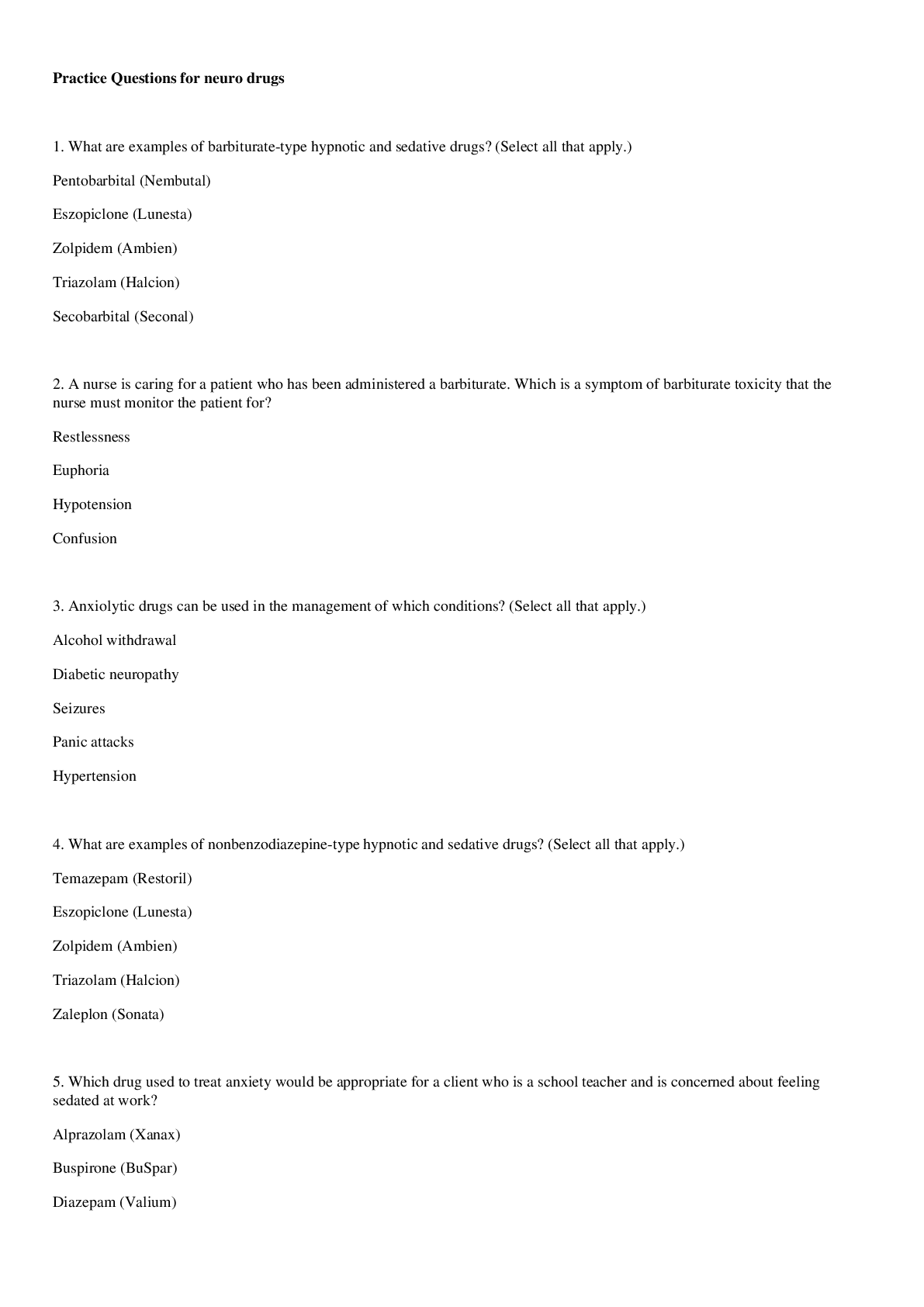
Reviews( 0 )
Document information
Connected school, study & course
About the document
Uploaded On
May 24, 2020
Number of pages
38
Written in
Additional information
This document has been written for:
Uploaded
May 24, 2020
Downloads
0
Views
73

